April 2025
Ever since I had done the camino portugués the year before from Vigo to Santiago, I was dreaming about my next camino. I decided to do el Norte and then continue to Muxía, the latter inspired by my friend whom I had walked with on my last camino. I had a total of 10 days walking.
Initially, I had planned to start from Luarca to finish in Santiago, but as I was researching, it seemed complicated to get there from Santiago (I landed there). Vilalba being closer and only one hour and a half away from Santiago by car, I decided for this option. However, even this was complicated, and my only option seemed to be blabla car, or getting to Lugo by train and then taking a bus to Vilalba. After a few rejections, I finally found a blabla car willing to take me.
Day 1: Vilalba to Parga – 28km
The day before I started my camino, I had arrived in Santiago under a bright and sunny sky – a perfect beginning. I had just enough time to collect my credencial at the centro de acogida de peregrinos before taking a blablacar to Villalba, where I would start my camino. The ride took about an hour and a half. Somewhere along the way, we hit a patch of heavy rain. I remember thinking, “This is really bad timing… the weather won’t get any better.” And I was right.
Luckily, I had a private night at the albergue A Carballeira, and it was a luxury to have the space all to myself.
The following day, I started walking at 10 a.m. I truly needed the rest. I woke up with a headache and spent some time massaging it away. After a meditation focusing on the energy center of the heart, I finally felt ready to begin my journey.


The first two hours were peaceful, with only a light drizzle. My clothes held up well at first, but then the rain picked up and became heavy and steady. By then, I was soaked from my shoes to my trousers. Thankfully, my chubasquero (poncho) kept my upper body and my backpack dry. Thinking it would pass, I took shelter at a farm for a couple minutes. It didn’t, so I kept going soon afterwards.
What struck me the most that day was the solitude. Compared to the camino portugués, I didn’t meet a single pilgrim on the road. I wondered: was it because I started late? Or maybe was it still too early in the season?
Despite being alone, I didn’t feel lonely. In fact, I enjoyed the solitude. Though I have to admit, my thoughts wandered quite a bit in the beginning. I kept thinking about the future – my dream of moving to Spain, opening my language school. I had to remind myself not to be too hard on myself for staying in Switzerland a bit longer than I had thought doing a job I love while I work on building something meaningful career-wise. I am at a good place in my life, being exactly where I’m meant to be.
The walk itself took about 4.5 hours with almost no breaks – there simply wasn’t anywhere to stop. No cafés, nothing. And with the rain, I had no choice but to keep going. The path was mostly flat, with a few gentle ups and downs. I passed through small villages, forests, and sometimes walked beside main roads. Not the most picturesque stage, but still a good start.
I reached Baamonde at around 3 p.m. and finally stopped at Bar A Rotonda for a big cheese sandwich. I saw a few pilgrims there, most carrying only tiny backpacks – probably had their luggage transported.
Baamonde didn’t leave much of an impression on me. It didn’t feel particularly charming, and accommodation options were limited: the pilgrim’s hostel or a more expensive one that cost 45 euros per night – not worth it for me.
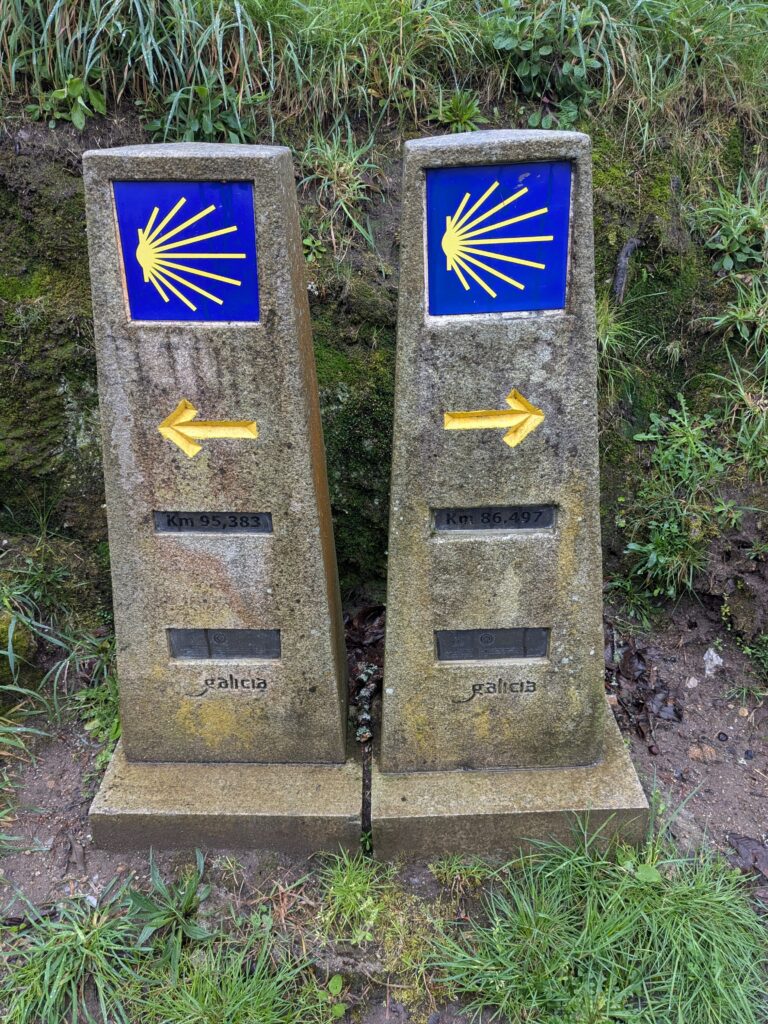
So, I decided to keep walking. I found another albergue about 2 hours further, along an alternative route that’s 8 km shorter than the traditional one.
I called the albergue just to make sure it was open and she asked me whether I wanted to participate in the community dinner. It was a tough decision, especially with the heavy rain pouring again. I kept encouraging myself aloud: “You can do it. Enjoy yourself. Be grateful for this experience.” I was reaching my limit. But it was worth it.
I arrived at Parga Natura Alojamiento – recently renovated, warm, and full of charm. I had a hot shower, then dinner for 15 euros. Honestly, what more could I ask for? The meal was delicious: salad, beans, mushroom soup, natillas for dessert, and red wine – shared with a friendly Danish guy.
In my dorm, there was only one other elderly man. Once again, I had the space almost all to myself. What a perfect way to end the first day of this camino.
I usually end my day with a meditation relaxing my body and giving love to myself while focusing on parts of my body that need my attention. I had sprained my ankle just one week before starting my camino, so my left foot was already bandaged. I was able to walk without major complications, although I knew I had to be careful, my foot was still healing and hurt a bit.
Day 2: Parga to Sobrado dos Monxes : 25km
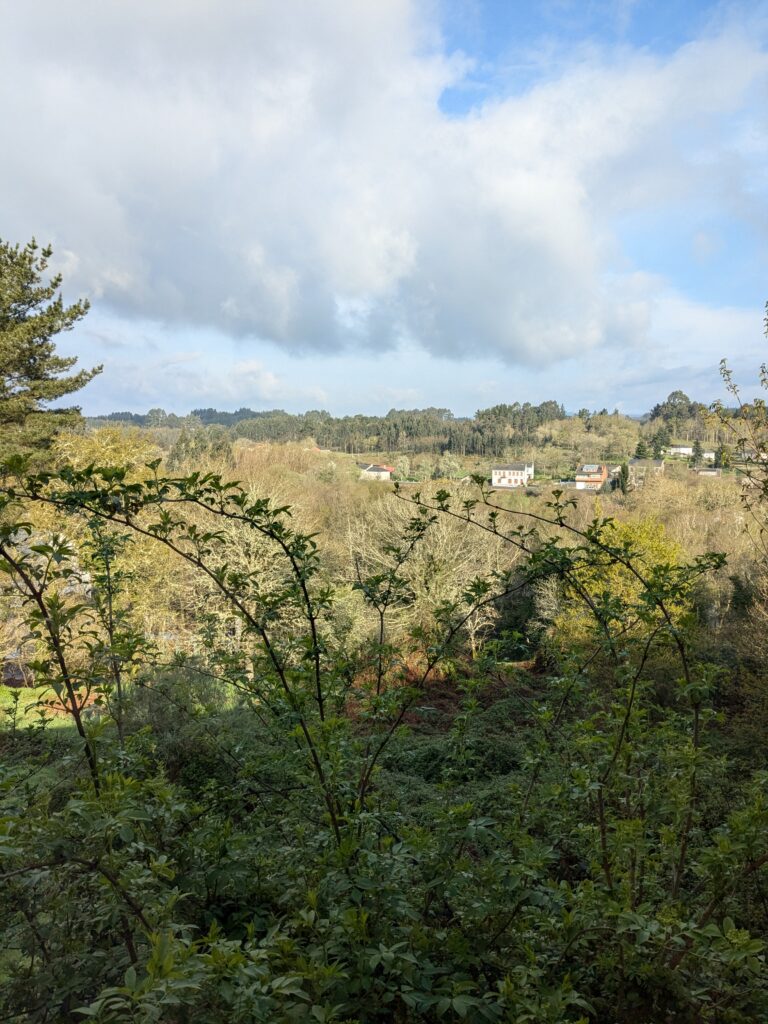
I departed late again that day – around 10 a.m. – after breakfast shared with the Danish guy. That albergue really felt like home. To my surprise, it wasn’t raining. The sky was overcast, but the sun peeked through now and then.
According to the map, there were supposed to be two bars along the camino, but both were closed – probably because it’s still the beginning of the season and today is Sunday. I took short breaks here and there, nibbling on snacks and drinking water, but it wasn’t nearly enough to fuel me for 25 kilometers.
The first half of the route led me through peaceful forest paths – my favorite kind. I was immersed in the moment, listening to birds chirping all around me. There were ups and downs on thai part of the camino, but nothing too significant. I didn’t see another soul for hours. My mind was calm, and I managed to let go of my worries. I even practiced some of abundance meditations, focusing on thoughts of love, gratitude, and the idea that I have all the time in the world to do what I truly want in life.
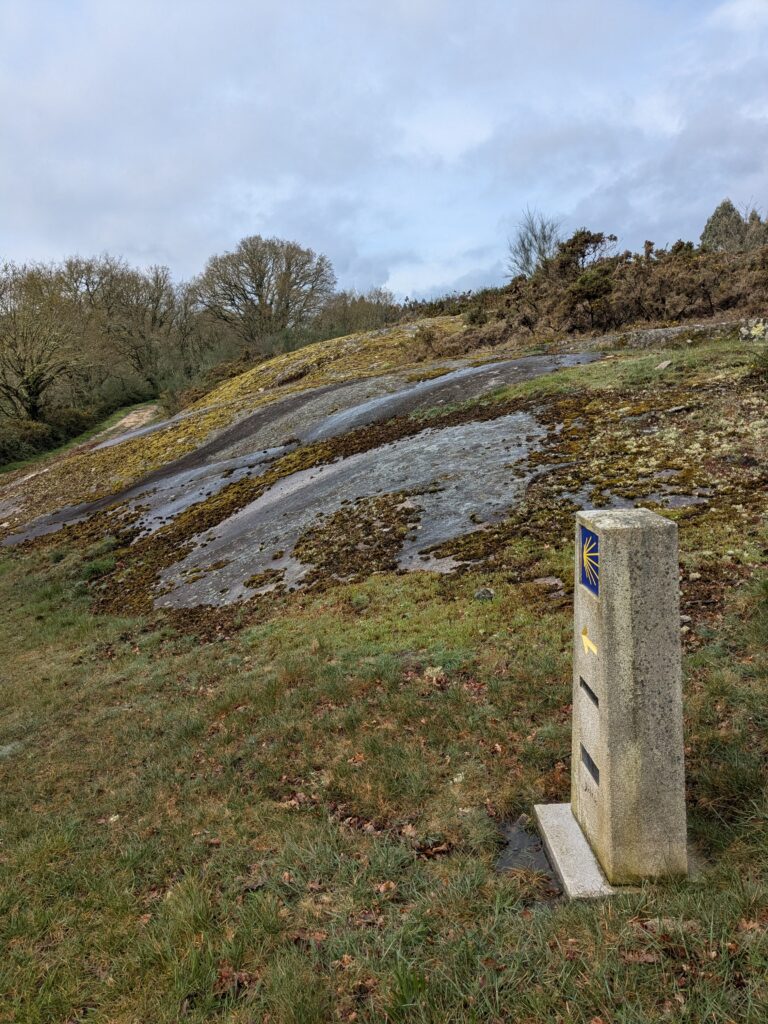



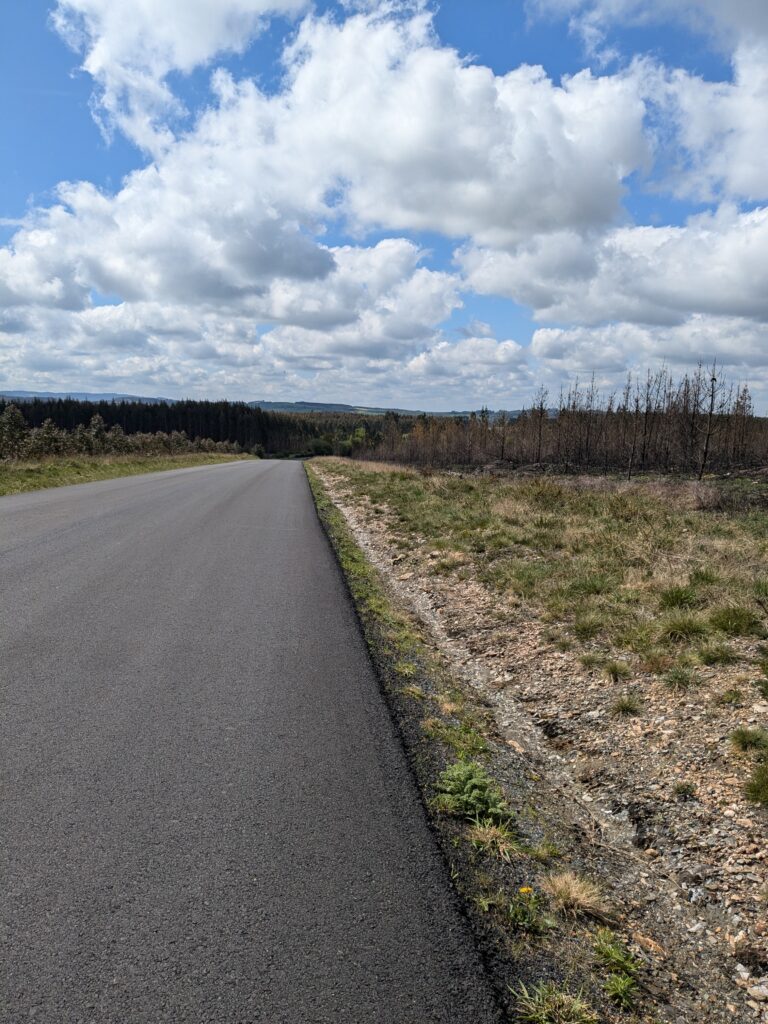
The second half was more challenging – long stretches of road that seemed to go on forever. Still, I was surrounded by stunning landscapes that kept me going. I passed only two cyclists and one pilgrim the entire day. I met that pilgrim by chance at Casa Cotos, a café bar about 7–8 km from Sobrado dos Monxes. It was a bit of a climb – about 200 meters off the camino – but I was so glad I found it. I was running low on water and food, and energy by then.
I finally reached albergue Lecer in Sobrado dos Monxes at 6:30 p.m. I had lost about 20 minutes earlier after mistakenly following a shorter alternative route that didn’t actually lead to the village. There were only four of us staying there – it was the first day the albergue opened for the season.

After settling in, I visited the monastery, the main (and really only) attraction in the small village. Later, while heading out for dinner, I crossed paths with the Danish guy again. It was already 9:30 p.m., and he had started walking around 2 p.m.! We ended up having dinner together.
Day 3: Sobrado dos Monxes to Arzúa – 22km
I started at 9am that day. There was light drizzle, with heavier rainfall at times throughout the day. I met 4 pilgrims that day, which is more than the days before…
I met a German girl and I walked part of the camino on the rain, maybe about 10km. The café bar we both wanted to stop at (Rico, in As Corredoiras) was permanently closed. I welcomed the company, after having walked alone the days before.
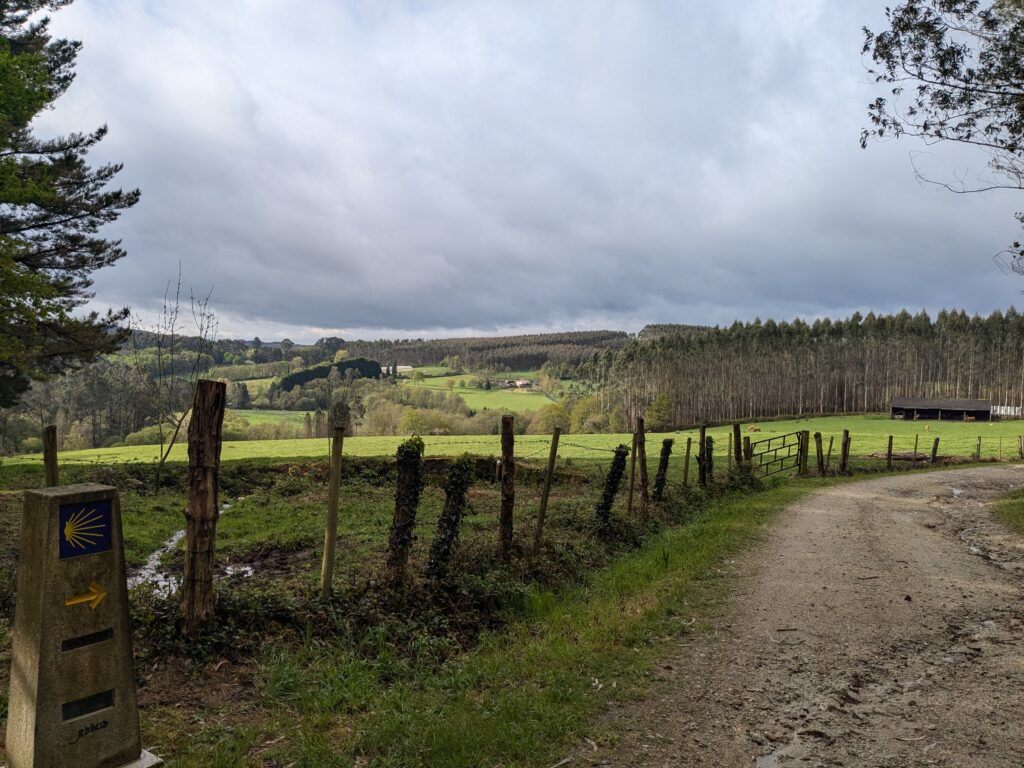


In Arzúa, we had churros, it was a luxury after so many days of walking and only having limited options on the way.
After my third day of walking, I treated myself to a private room in a pension. I really needed it. The French Camino merges with the Camino del Norte here, and I suddenly found myself surrounded by a crowd of pilgrims. It was a big change from the solitude and silence I’d enjoyed on the Camino del Norte.
People had warned me that the French Camino gets really busy during the last 100 km – from Sarria to Santiago – and especially during Semana Santa. Still, there were positive sides – like having more cafés and bars on the way, just like the Camino Portugués. And that private room? Absolute bliss. I took time to meditate, do a bit of work for my continuing training course since I had a deadline soon, and just breathe. Meditation is part of my camino. It was a gift to myself, and I really felt the benefit.
Day 4: Arzúa to Santa Irene – 17,5km
The evening before, I discovered I got bitten by bed bugs. I first wasn’t sure what it was, so I decided to wait out the night. My hands and my back felt itchy – it must have been in the albergue in Sobrado dos Monxes.
Enjoying the luxury of my private room, I started my day with two meditations. I then stopped by a pharmacy to get something for the bed bugs.
I left Arzúa at 10:30 a.m., later than most pilgrims heading straight to Santiago (about 30 km away).
I didn’t reserve anything in advance. Around noon, I called an albergue in Santa Irene, and they still had a bed in the dormitory. Perfect.
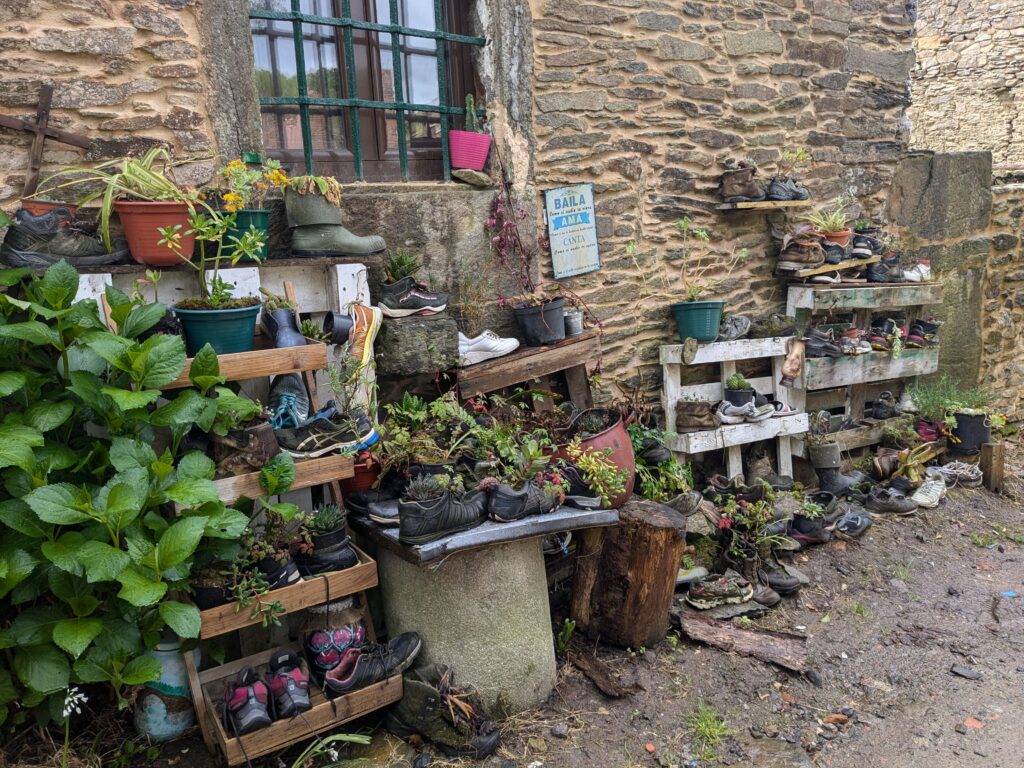
The weather was lovely, between sunshine and light rainfall.
After about one hour of walking, I met a German guy I’d met the day before at a café I had stopped at with the German girl– he’d done the entire Camino del Norte in about 33 days – and walked with him. His stride was twice as long as mine, so I had to hustle to keep up. We stopped for food and rest at a café when it started to rain. Eventually, I continued alone.
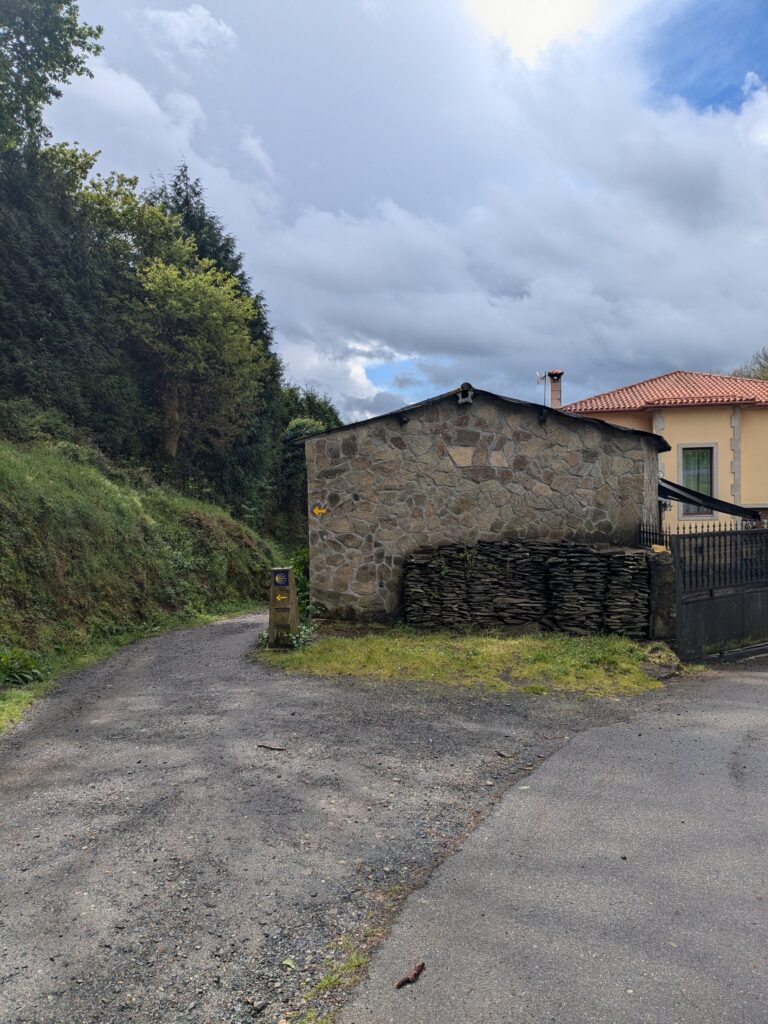
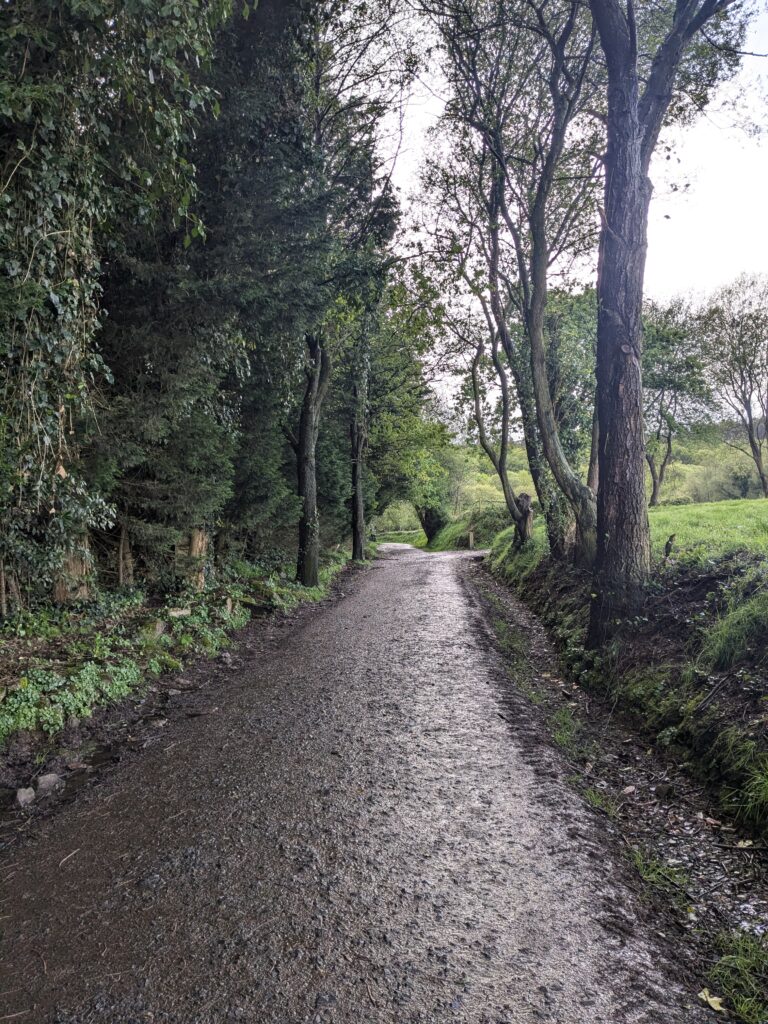
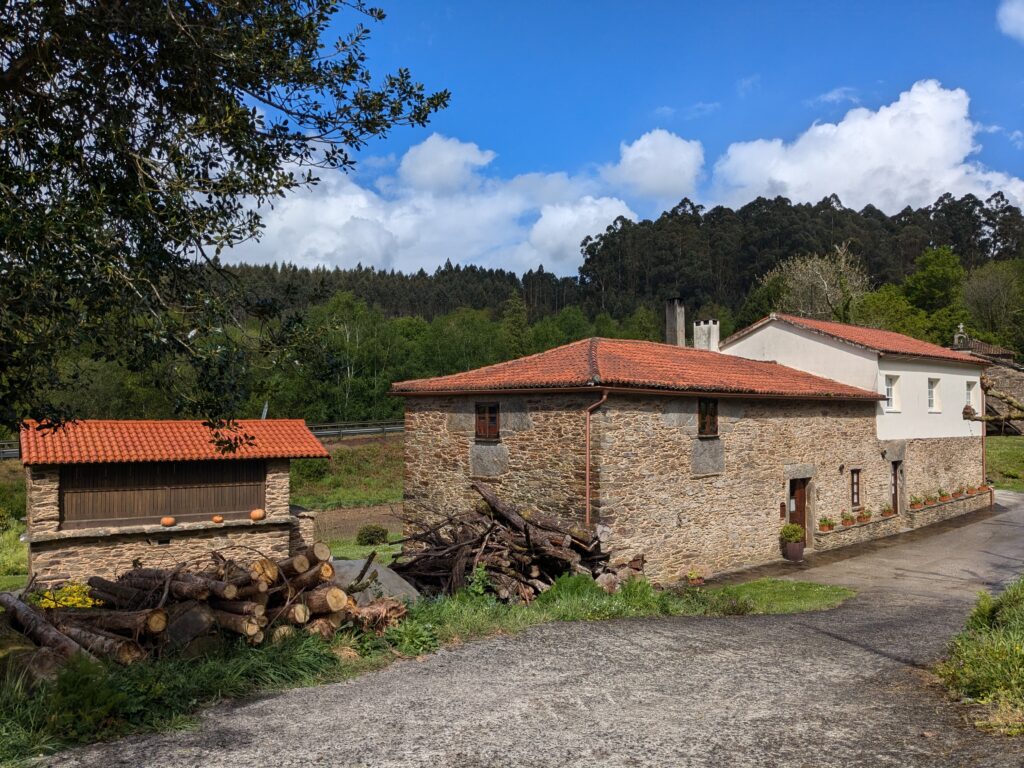
I arrived at the albergue at 4pm, showered, and since it hadn’t started raining again yet, I meditated outside on the terrace. That meditation was magical. I must have lost track of time because they had to call me in for the community dinner – fish, soup, dessert – at 7:30 p.m. I shared the table with some Spanish pilgrims (maybe from Madrid), a group of Chileans, and an Italian guy – we all spoke in Spanish. Nice vibes.
The albergue was cozy and comfortable.
Day 5 : Santa Irene to Santiago de Compostela – 17,5km
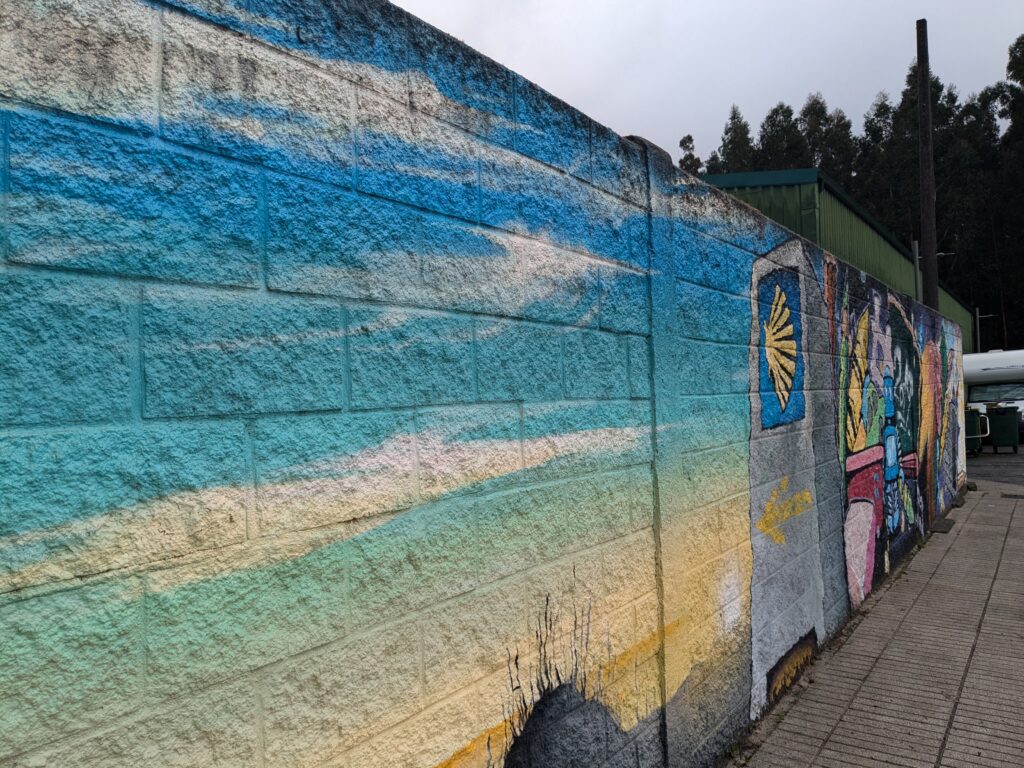
That night in the dorm, I didn’t sleep well. People were snoring like tractors, and everyone started waking up around 6:45 a.m. Way too early for me. I finally got up and walked out around 8:30 with the Italian guy. We walked together for half an hour until O Pedrouzo. He continued alone, as I wanted to get breakfast.
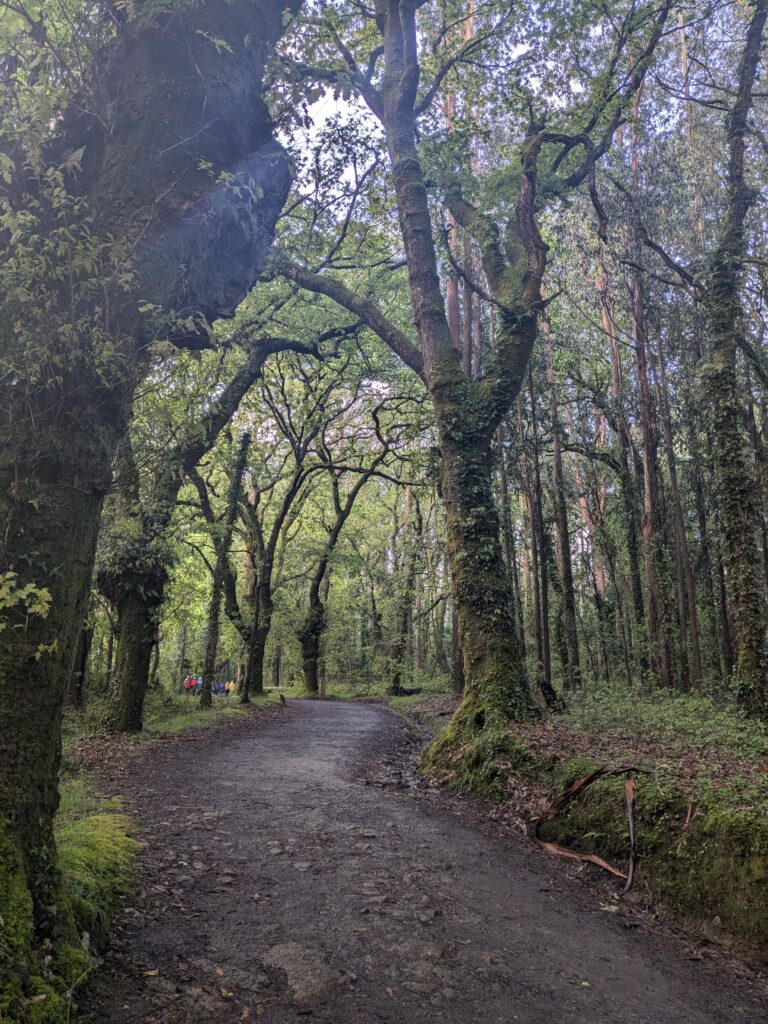

About 10 km before Santiago, I bumped into the German girl I’d met earlier. We finished the walk together. The path got so crowded – families, teenagers, big groups… not super peaceful. But at least we shared stories and distracted each other.
Once in Santiago, she went to her hostel, and I kept walking to the cathedral with my full backpack. I wanted to reach “km 0” with everything I’d carried.
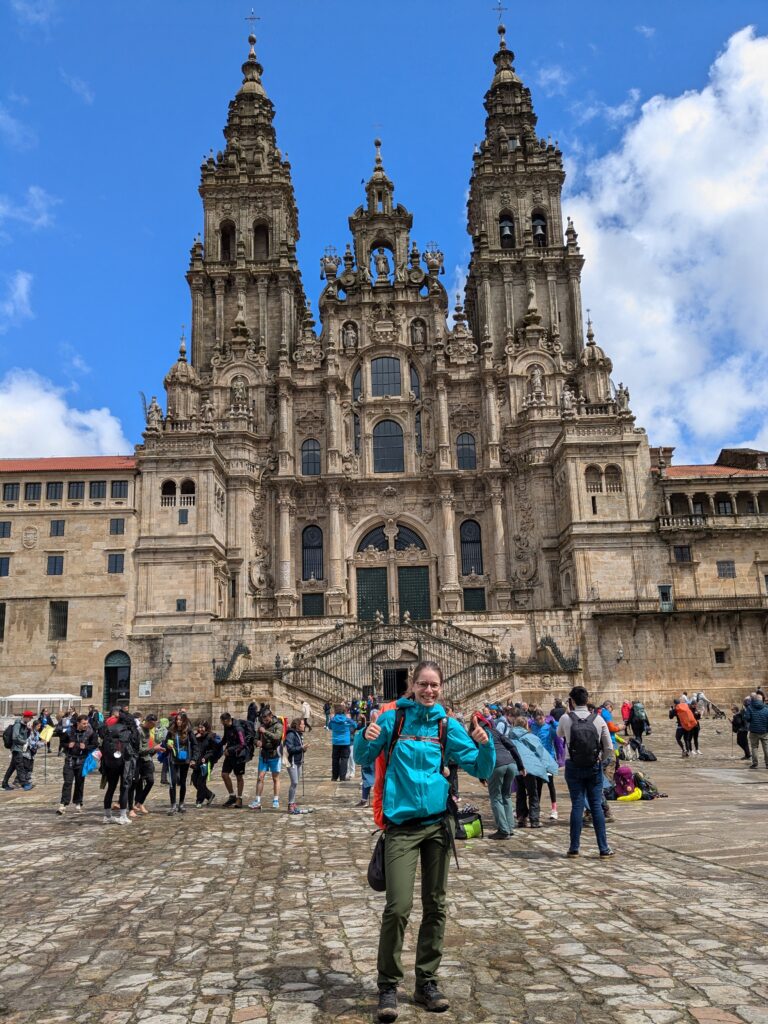
Then I checked into the hostel I’d booked earlier, dropped my stuff, and went out shopping clothes.
That day, I had been walking being preoccupied along the day of having to deal with my issue of bed bugs. It had gotten worse the night before, I discovered my legs had been attacked as well. So I bought new clothes in Santiago, gave mine for washing, and went to the pharmacy for tea tree oil, cortisone cream, and antihistamines. It helped.
Later, I wandered around Santiago. It was evening already, as it has been quite a hussle getting things done. I went to get my Compostela, I didn’t get the certificate of kilometers this time. There were about 2400 pilgrims who arrived in Santiago that day. I made it just in time for the pilgrims mess at 7pm at the Cathedral.
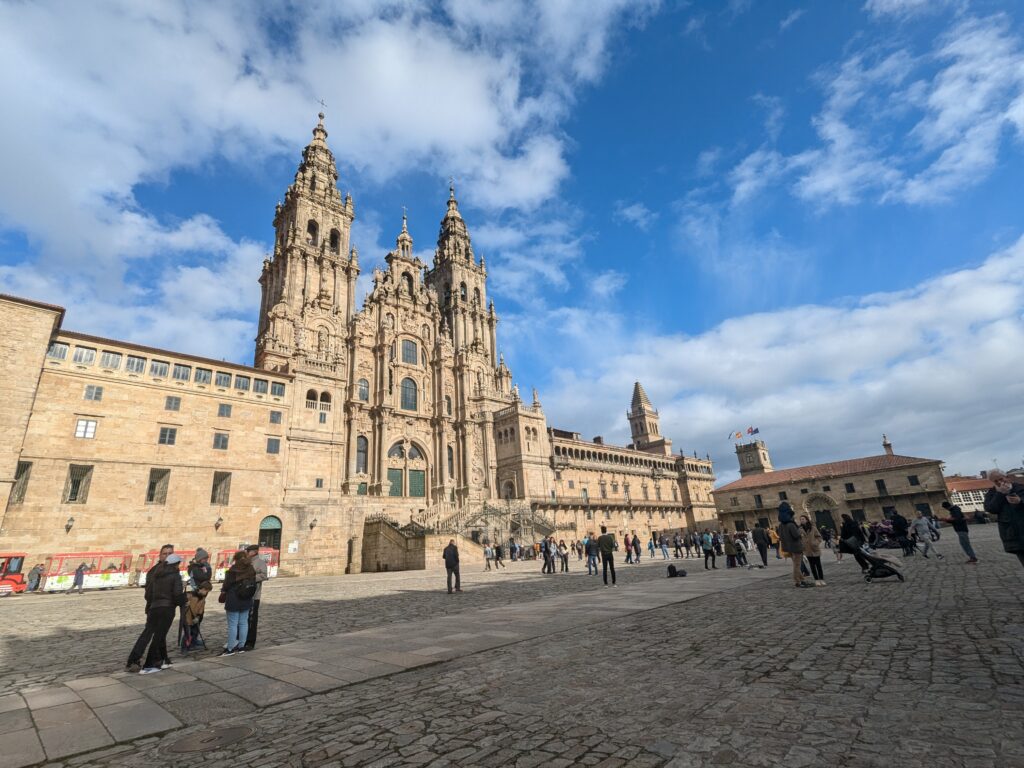
That evening, after dinner, I searched for a queimada – the Galician ritual to chase away bad spirits. My friend who I had walked the Camino Portugués with, had mentioned it, and I really wanted to try it.
There was a procession happening – Semana Santa vibes, which I found a bit scary even, reminded me of Ku Klux Klan stuff. But I managed to find a way around and found the bar Fuco Luis another friend had told me about.
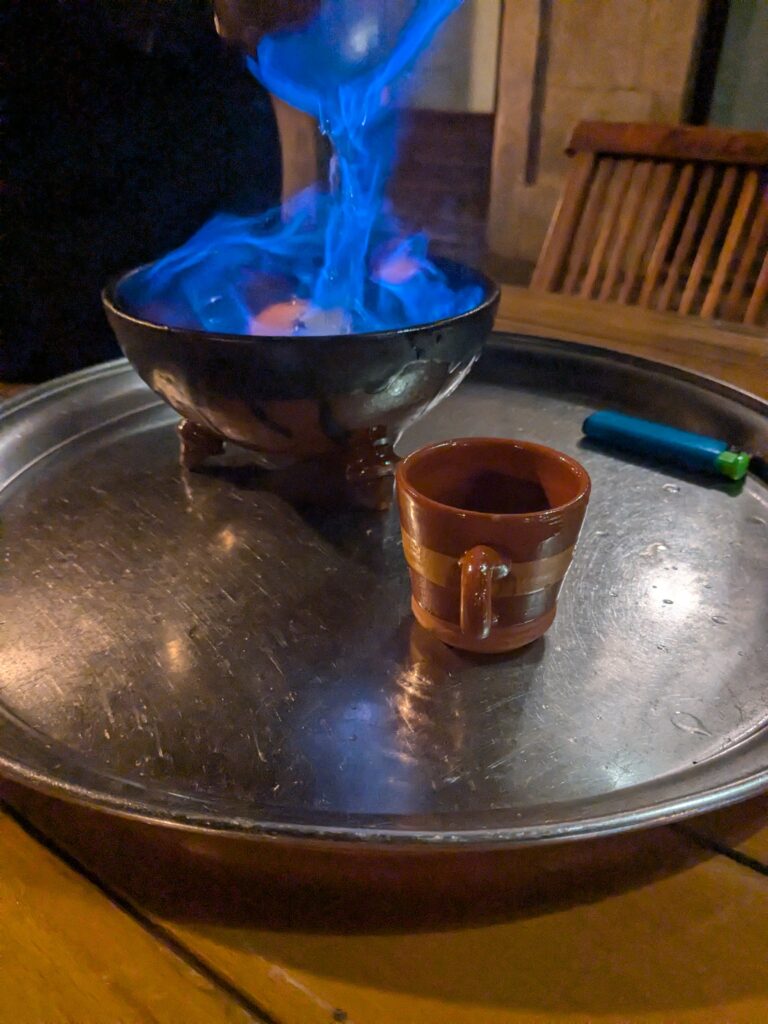
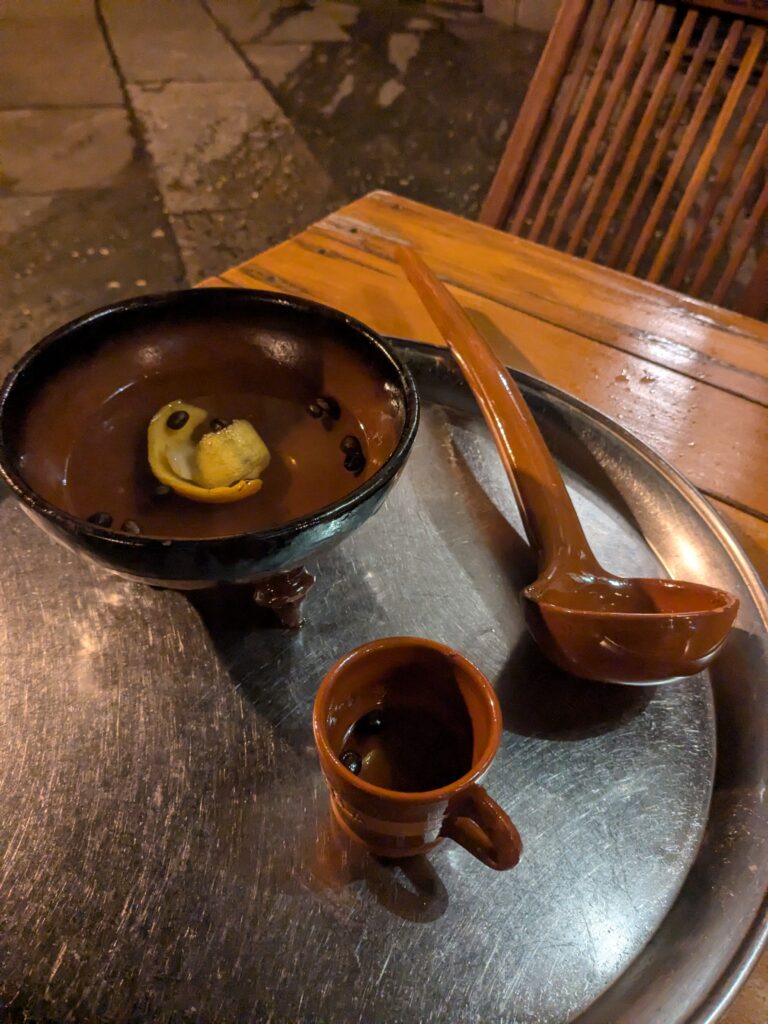
At first, the waitress said they only do the queimada for two people or more. I told her I didn’t have anyone with me, but she offered to do it just for me if I paid double. Deal! She took me outside, lit the queimada, and recited the traditional spell while stirring the flaming liquid. It was powerful. I didn’t drink it all, but the experience itself was more than enough. It was like a magical potion. I’ll never forget it.
Back at the hostel, I had the dorm to myself. I think it was around 3 a.m. when I woke up, because the Danish guy on the bed above me dropped his phone charger on me.
I had arrived in Santiago one day ahead of schedule, as I had thought of walking 6 days on the Camino del Norte before continuing to the camino to Muxía. This meant I would be able to extend my camino from Muxía to Finisterre. I hadn’t rushed through my camino, on the contrary I had taken the time I felt necessary and listened to my instincts and my body as far as possible.
Day 6: Santiago to Negreira. Camino to Muxía : 21km
The post office was open the next day (Holy Thursday), so I got a box, packed up souvenirs and the clothes I’d just bought, and dropped 1.5 kg from my backpack. Felt great.
Then, I bought breakfast at a bakery, gave a croissant to a homeless guy standing in front of it, and returned to the albergue to get ready. After a last good coffee in a specialty coffee shop, I headed to the cathedral. I stayed there a few minutes, admiring it, all the while the first peregrinos were arriving at the cathedral.
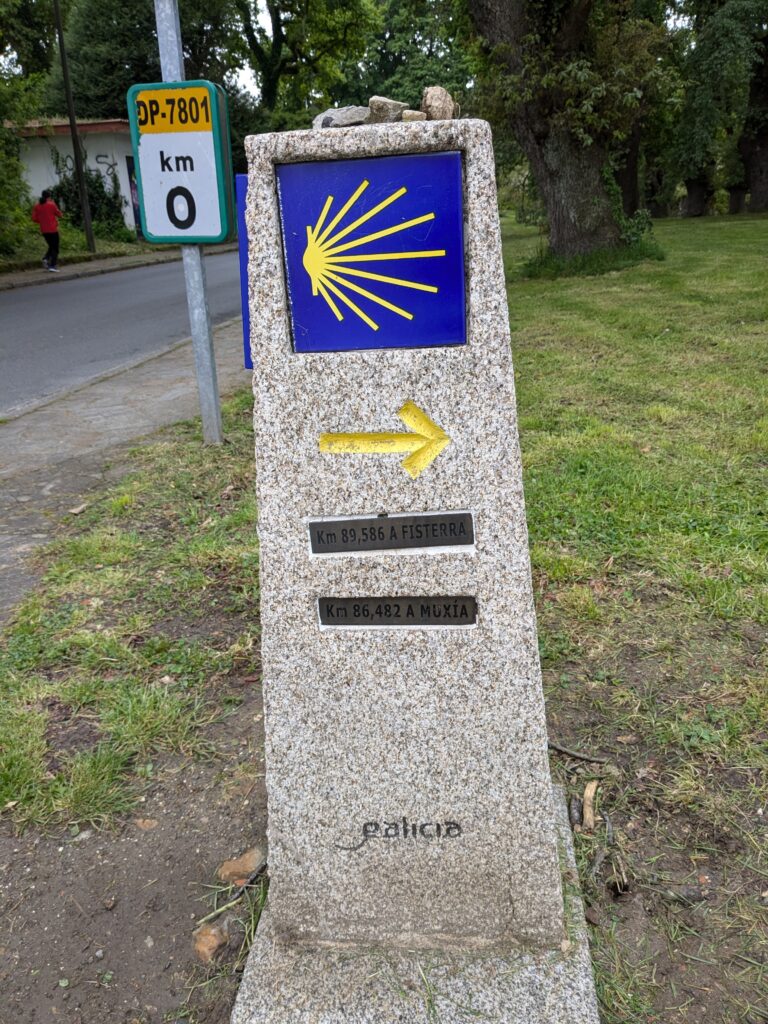
I left Santiago de Compostela at about 10:30 and immediately enjoyed walking alone again as soon as I was in the woods. It was a feeling of freedom and gratitude.
After walking for a while, there is a viewpoint where you can see the cathedral and the town of Santiago from the distance. What a view ! Pilgrims passing by me didn’t even stop to enjoy the view. I thought to myself, they are losing so much !
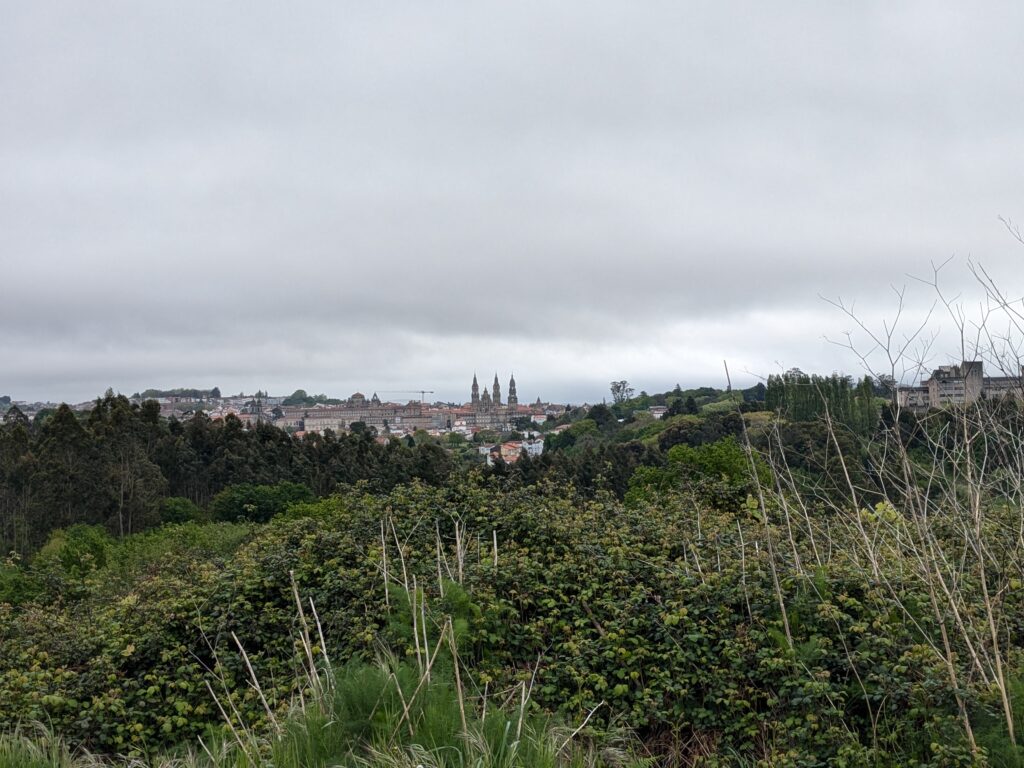
Most of the camino was going through wonderfully green forests. It was raining, but it wasn’t too bad. Not only did I admire the forests, I was looking and taking pictures of typical Galician houses. How could I not love the countryside ?
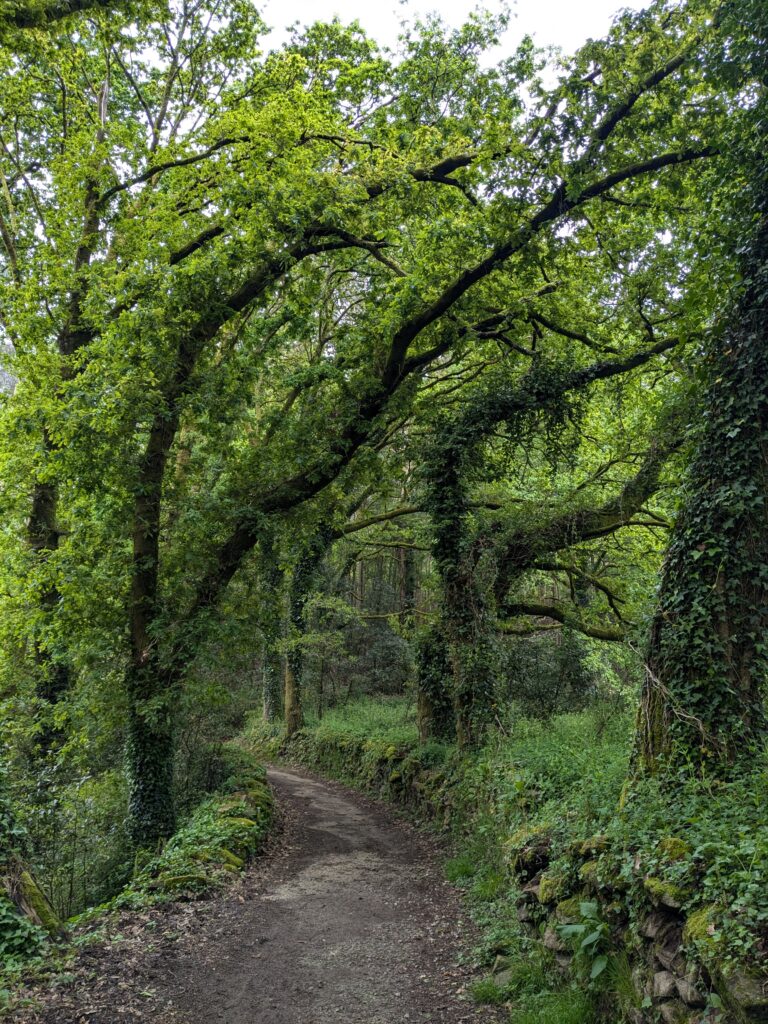
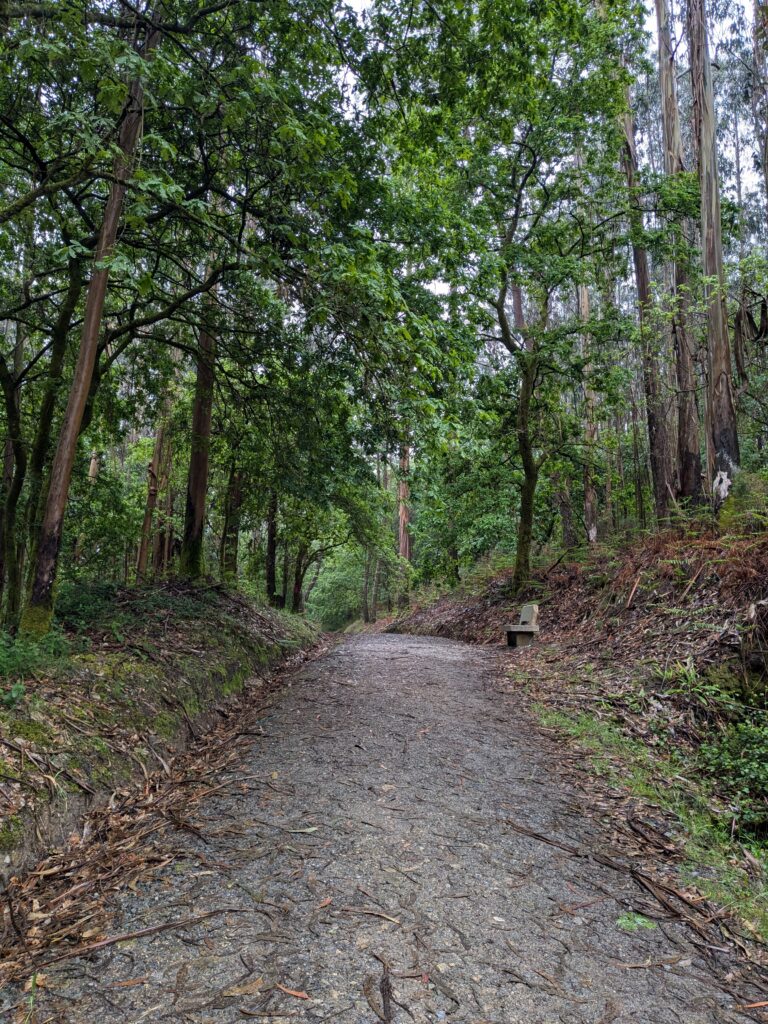
One of the most beautiful villages on the camino (and there actually is a sign stating “uno de los pueblos más bonitos de España”) for me was Ponte Maceira. Just before getting to Ponte Maceira, it goes quite steeply uphills for 3,5 km. Not even on the camino del Norte did it go that steep. Luckily, there were benches, but unluckily they were all wet, since it was raining lightly. I stopped in Ponte Maceira for a tea, and carried on, crossing the bridge and admiring the beautiful stone houses and the castle. I had stopped in Alto do Vento as well for lunch.
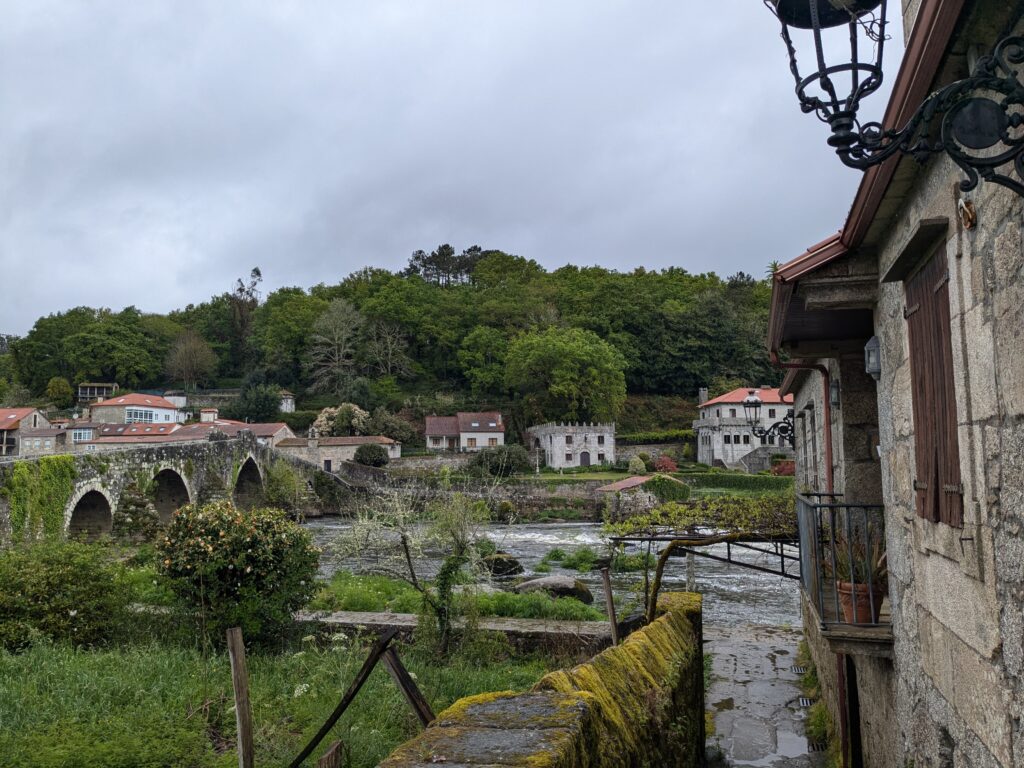
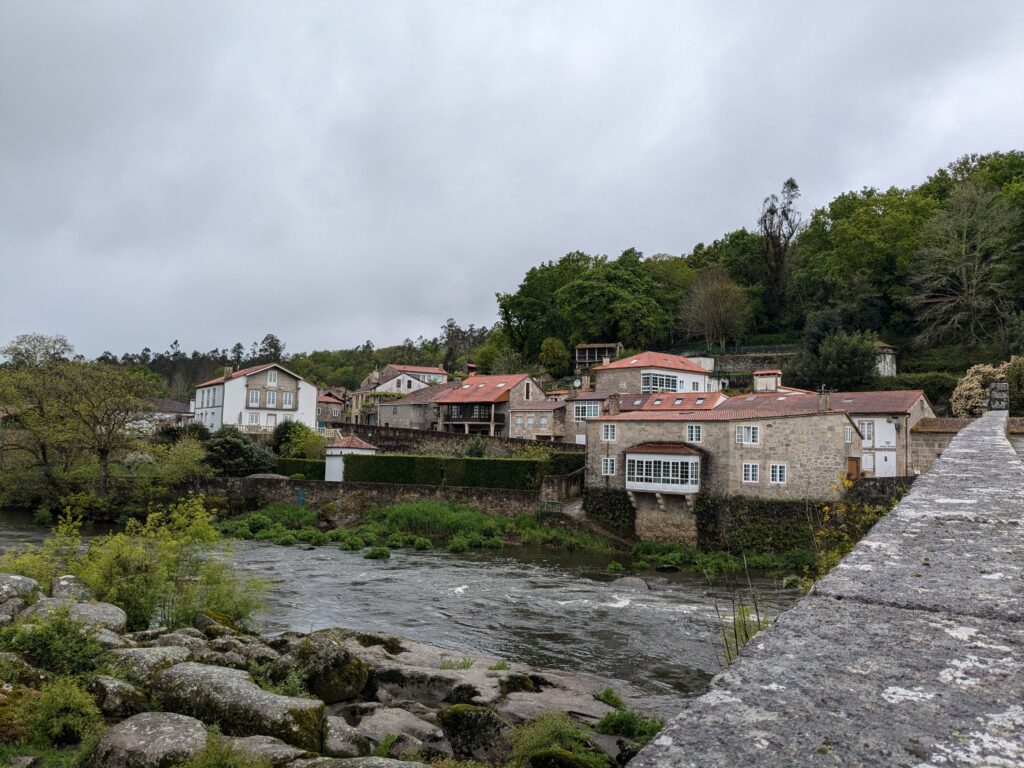
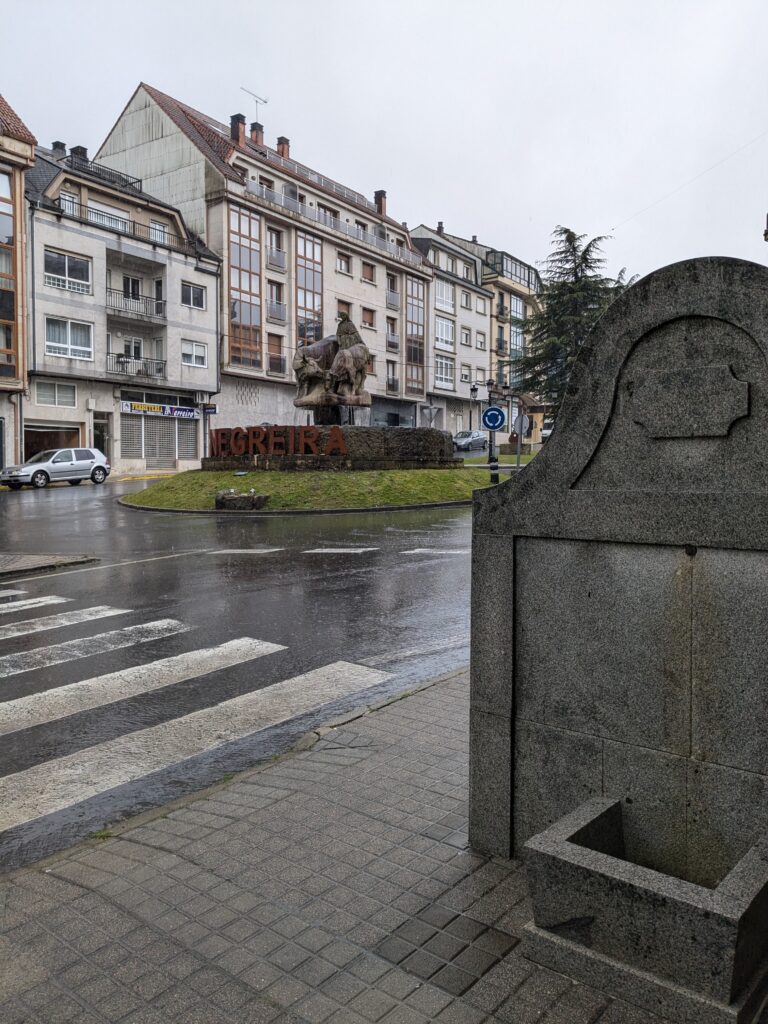
I arrived at albergue Coton in Negreira at 4pm. I had a warm welcome by José, he was over friendly with me, and it was one of the warmest welcome I had here in Galicia. I also recall the warm welcome in Parga after my first day’s walk.
As I was starving, the only option to get something to eat at this hour was walking under the rain to the gas station supermarket, which was half a kilometer away. I got some snacks and rested a bit. For dinner, I went to one of the few open restaurant – bars and got take away. I liked the company of the other pilgrims, one Italian couple from Sardaigna and a Portuguese guy.
Day 7: Negreira to Lago – 28km
I hadn’t slept well and my period started in the morning. On top of that, the weather was gonna be rainy all day long. In the morning, I thought I would walk as far as I could; I probably wasn’t gonna be able to walk the whole 33km of the etapa. As I was leaving Negreira at around 9:30 after breakfast at a café (where they gave me mini croissants and churros as free tapas!), it was drizzling a bit, but the path lead through breath-taking green forests, so I was protected.
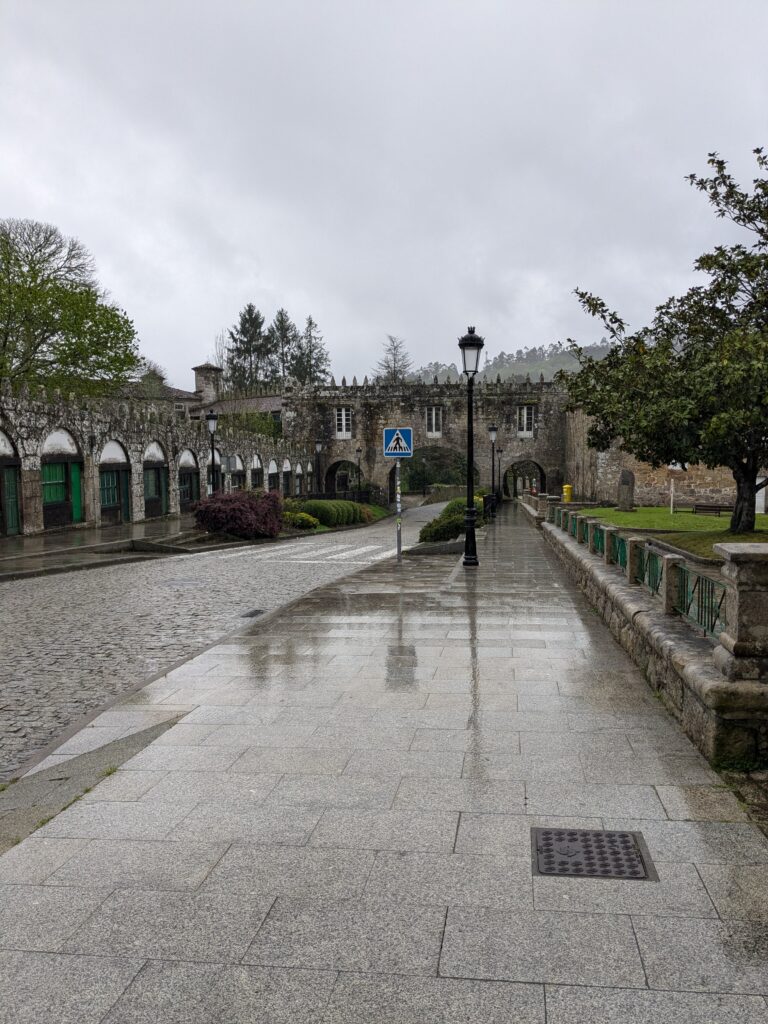
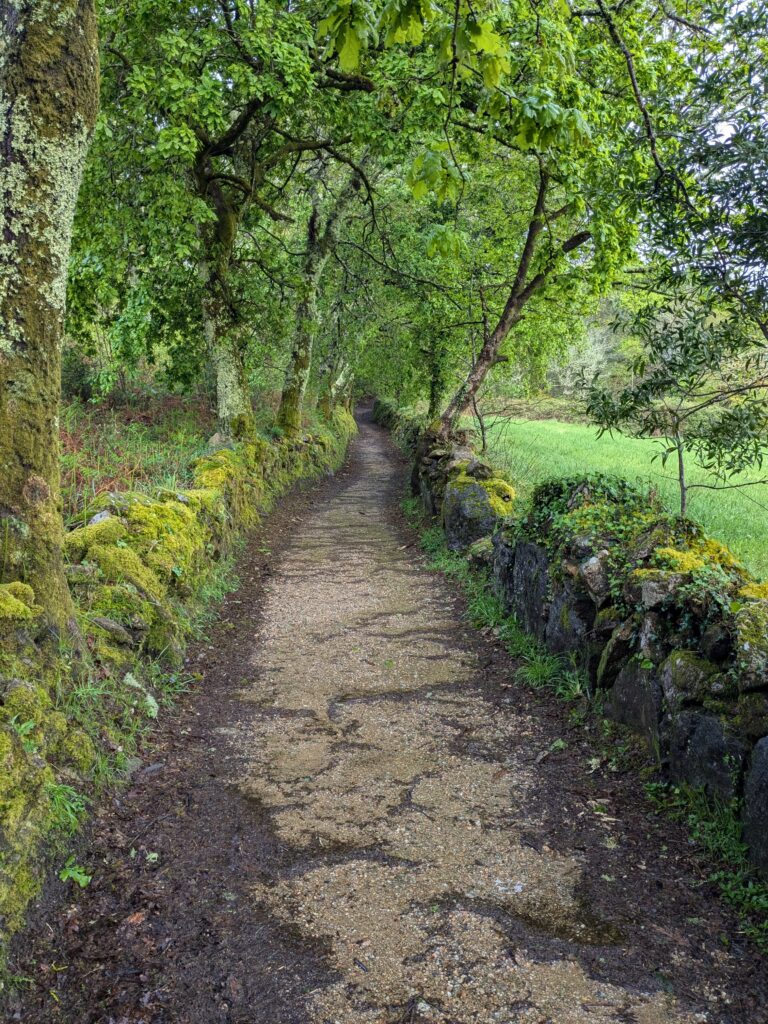
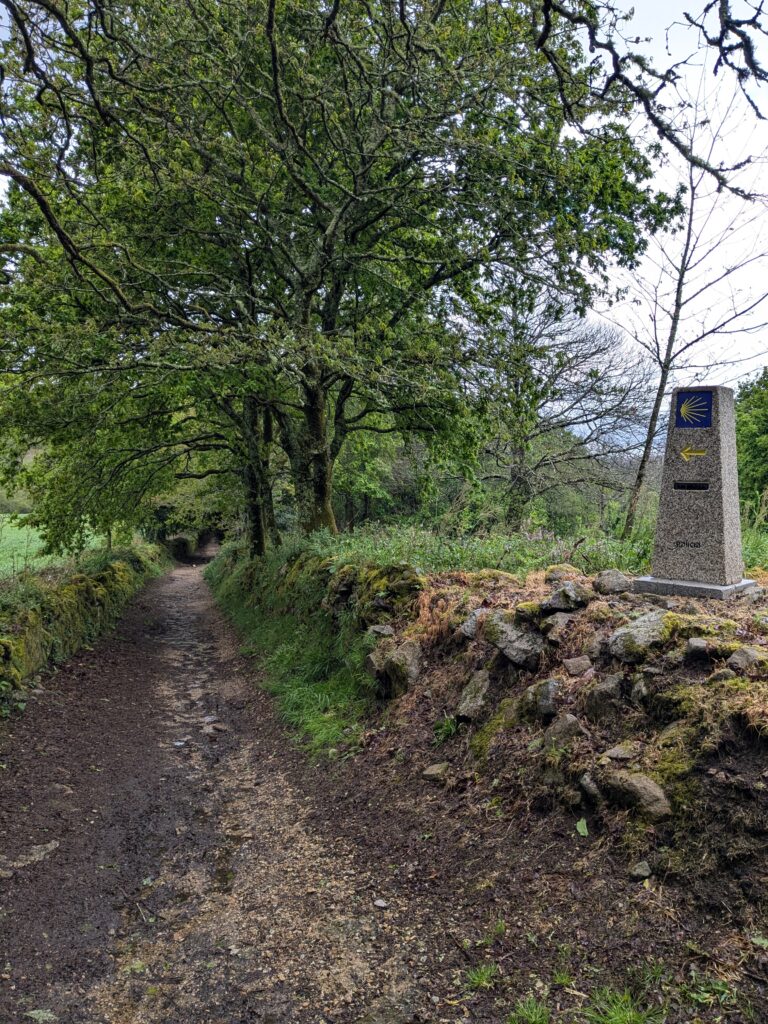
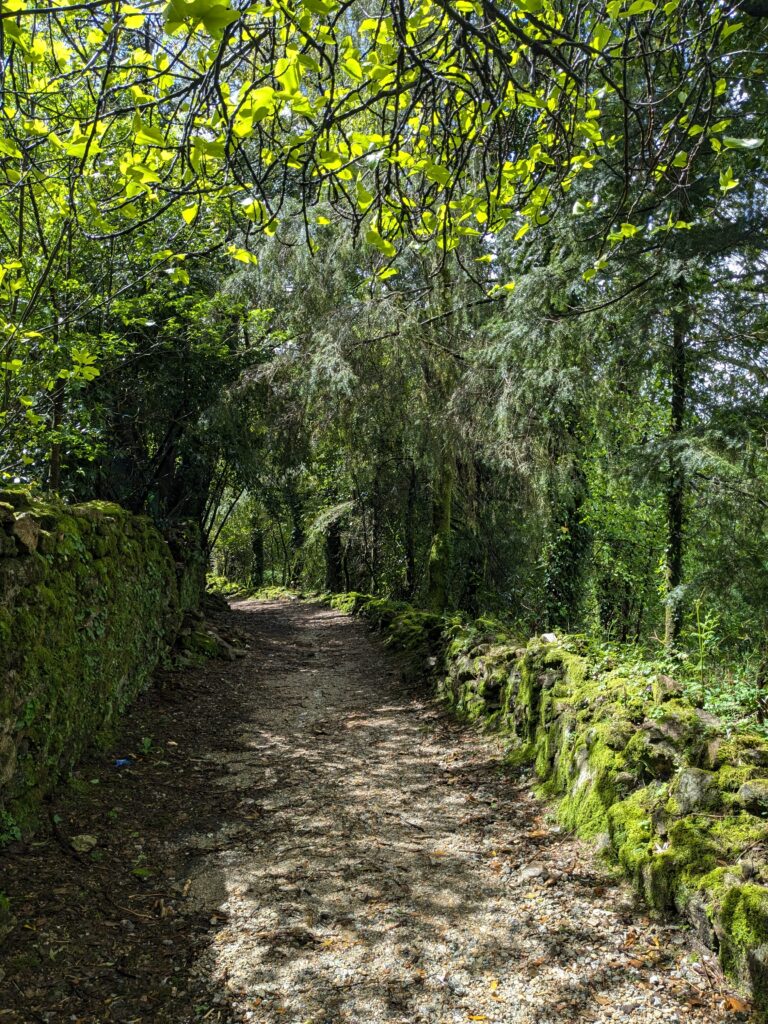
I enjoyed my camino all the way to my first stop in Alto da Pena approximately at noon. It was the most beautiful part of the day. I had a nice chat with some peregrinos who did the camino francés all the way from France, and then with some elder Spanish people, who were telling me about the previous caminos they had done. Among the Spanish group were two Germans, a woman of 72 and her son.
I came across the same people from Santiago these past two days. Although I must admit, even though there are clearly less people than on the camino francés, this camino is busier compared to the Norte. Today, I was daydreaming about my dream of buying a nice house in Galicia again, how could I not ? I love it in Galicia, I feel home.
I continued almost without a break until Santa Mariña, to potentially stop there after 21km. It was around 3:30pm I think. I had something to eat and drink and decided I would be able to continue. The weather hadn’t been too bad after all.

I “received” a load of heavy rainfall that had lasted no more than 5 minutes. The sun had just came out. That was my sign ! I think I left after 4pm and saw that the next albergue was about 7km away, that I could do ! “Let’s go!” – I thought. After walking for about 10min, the rain started again, and didn’t stop until I arrived at the albergue. In a matter of 15min, I was completely soaked, except for the upper part of my body. I had thanked the weather to be nice… Well, I’d tried. I still tried to be grateful, grateful to be walking in such a beautiful landscape. Every step I made I was thinking about the hot shower I would get. I stopped and took a long breath, and I thought “you can do it”. I repeated this thought in my mind and felt new restorative energy kicking in.
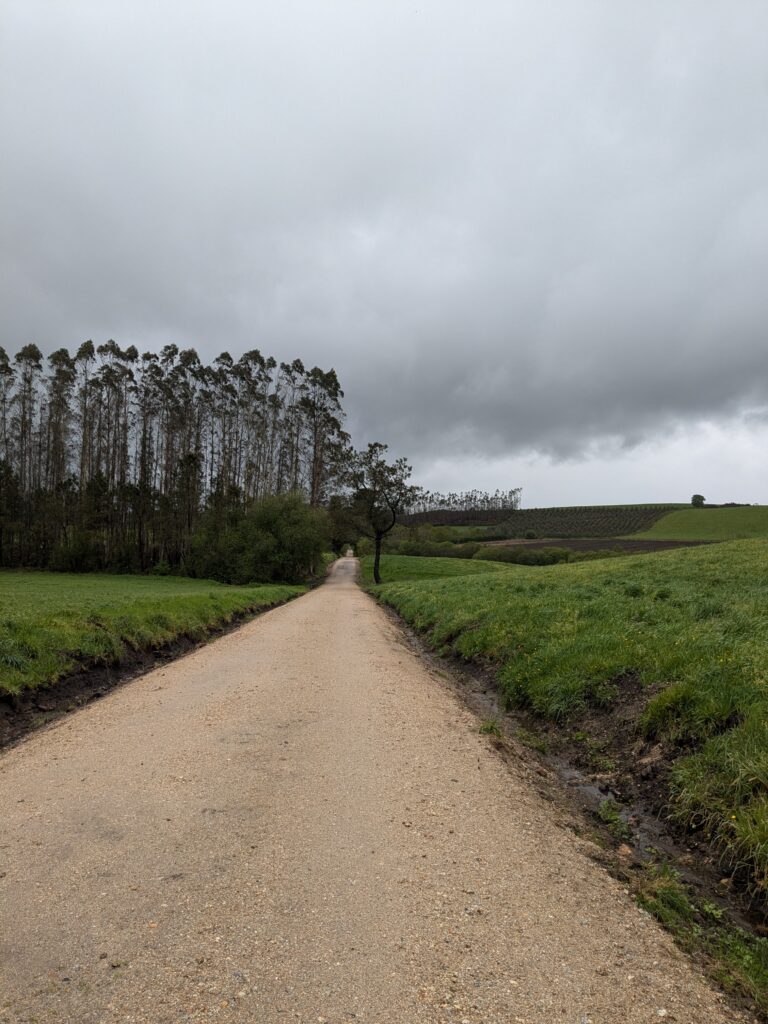
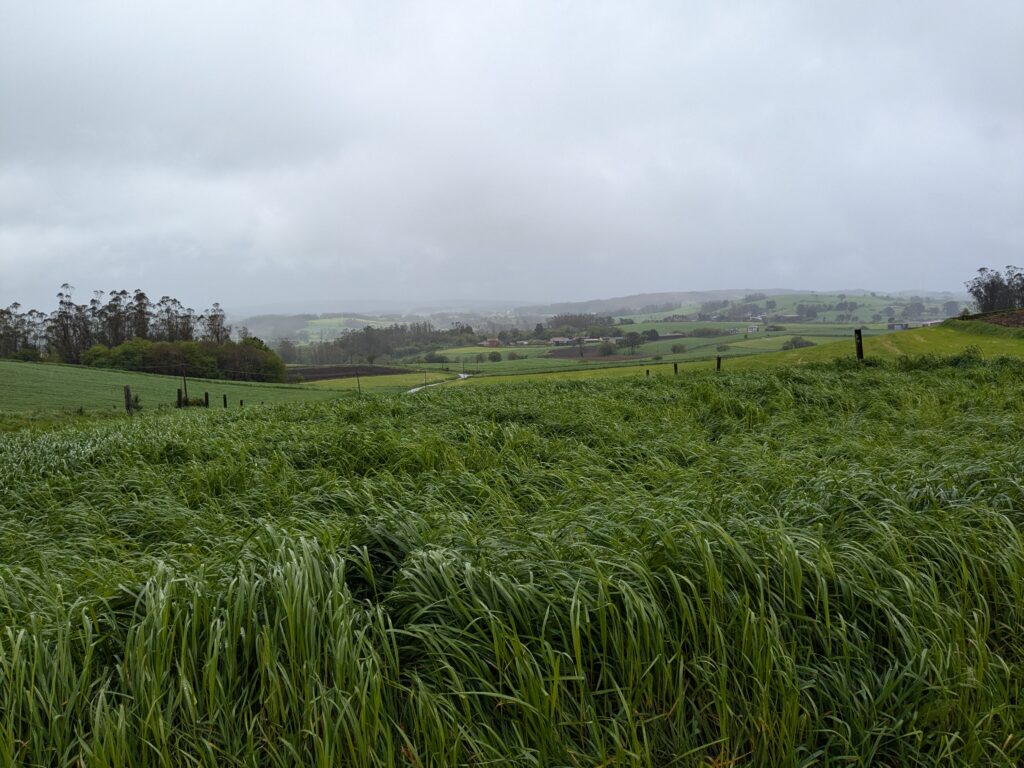
I remember the relief I felt when I finally arrived at around 18:30 at the albergue in Lago (Monte Aro). I had a wonderful shower and dinner with some other pilgrims. It was a nice feeling to exchange after a day of walking alone.
Day 8 : Lago to A Grixa – 23km

I started the day with a short meditation to soothe a lingering headache and a desperate attempt to dry my soaked shoes with a hairdryer—unsuccessfully, of course. At 9 a.m., I hit the camino again. My first goal was to reach Olveiroa for breakfast. The first half hour of walking was surprisingly pleasant: the sun shyly peeked out from behind the clouds, and I even caught a glimpse of a rainbow. I took it as a sign and felt filled with gratitude… but that moment of bliss was short-lived.
Soon enough, the rain returned—accompanied by wind gusts of 25–30 km/h. I pressed on against the storm, grateful for the occasional bus stops along the way that offered shelter. There weren’t many forest paths to protect me, so I trudged through exposed stretches until I finally reached Olveiroa at 11 a.m. The thought of breakfast had kept me going.
After a much-needed stop at one of the few open restaurant-bars, I headed back into the rain. Just outside Olveiroa, I encountered a flooded river. I had to cross it—feet submerged up to my ankles—completely soaking my shoes and trousers again. Only later did I learn there had been a road alternative. That hour of walking in drenched clothes was brutal.
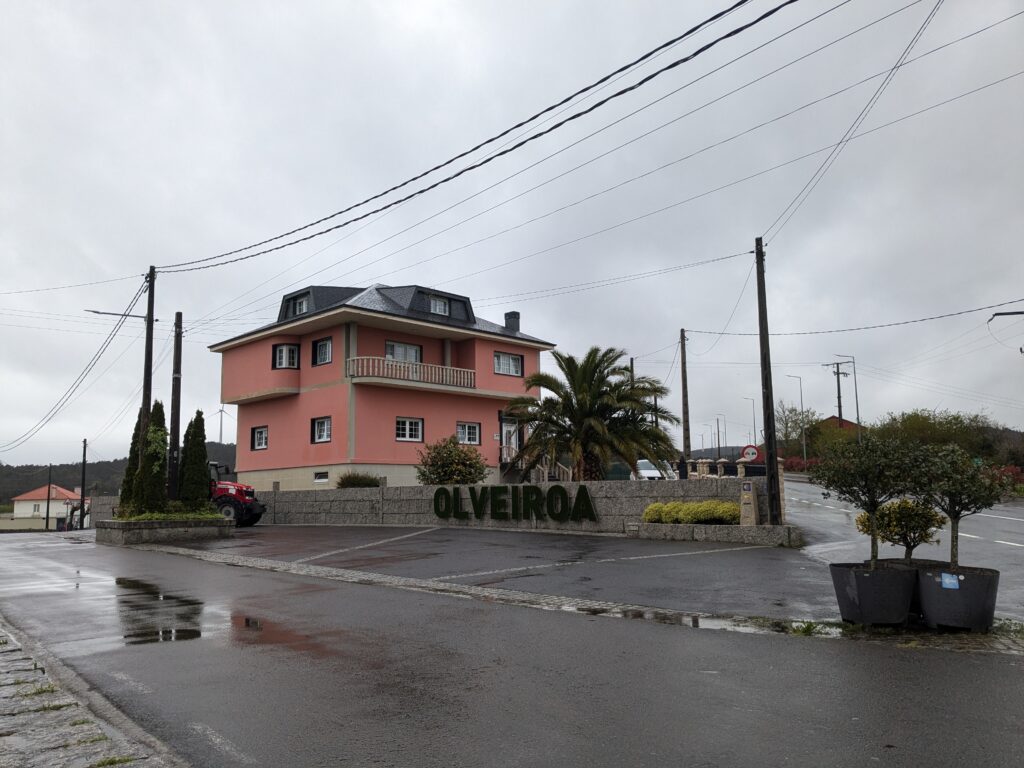
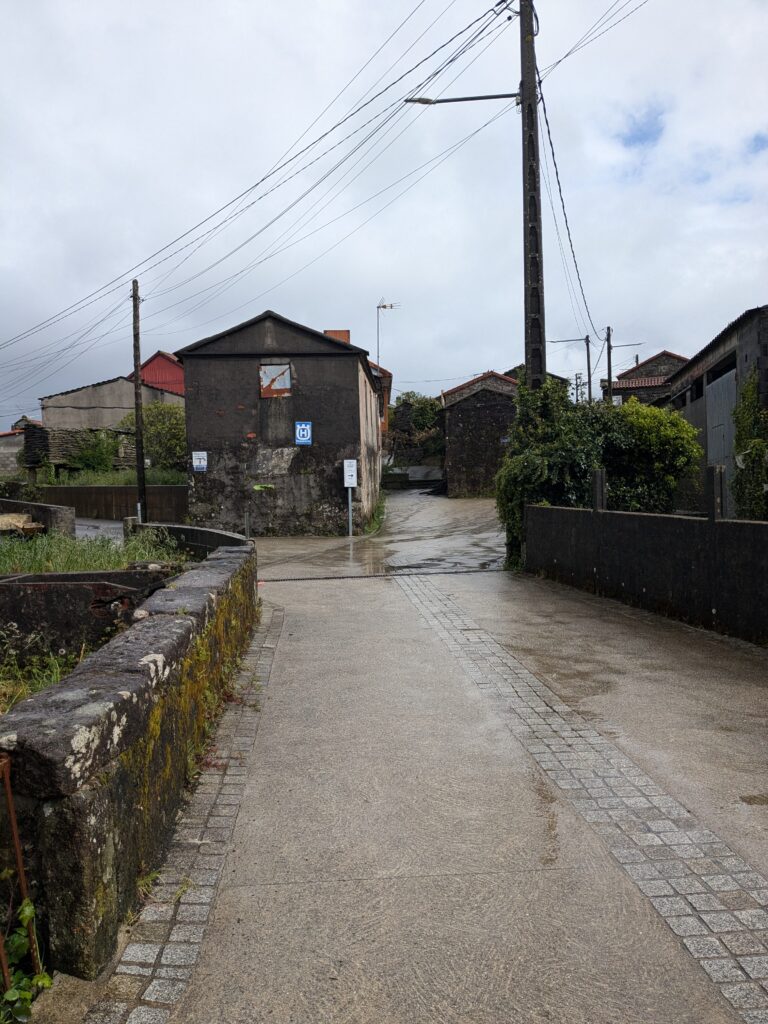


My next stop was, amusingly, a village called Hospital. It wasn’t the coziest café bar, but I was beyond grateful for a break. My stops were becoming longer, the storm showing no signs of easing. The wind and rain felt relentless—as if pebbles were being hurled at me.
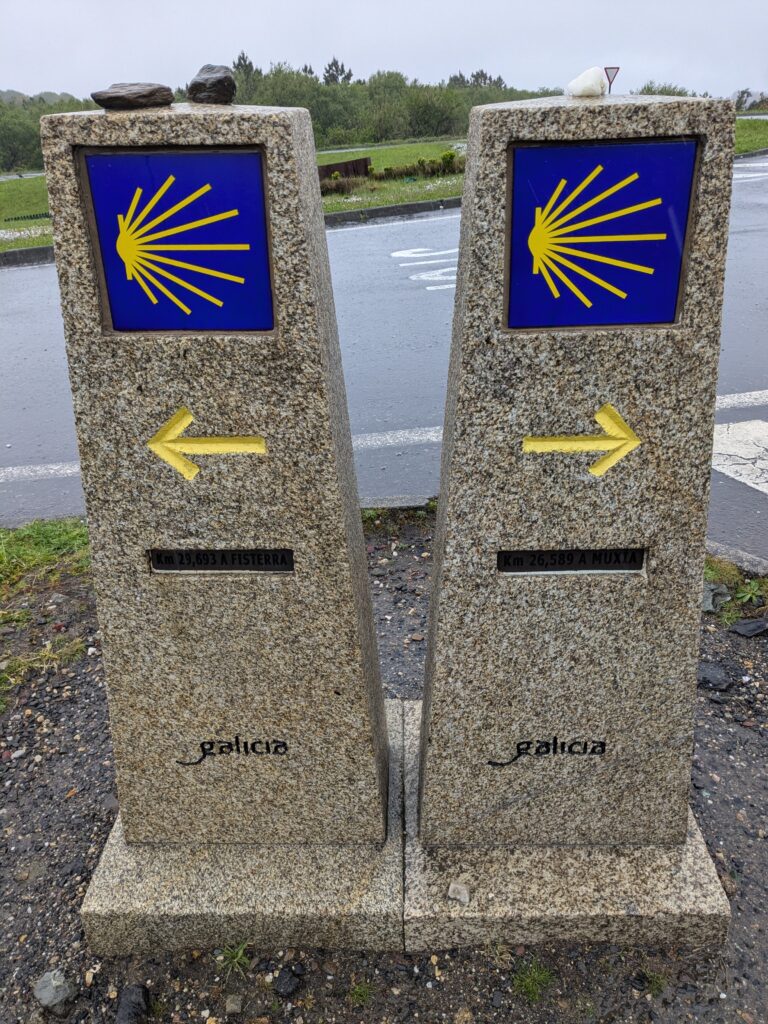
At Around 1 p.m., I resumed my walk, aiming for Dumbría, where I had the option to stay the night. I found short stretches of forest that offered shelter, but most of the path followed the main road. Passing cars splashed me as I walked through the unrelenting storm. At one point, completely exposed, I had a surreal experience: I thought I heard a baby crying and a woman speaking just behind me. Turning around—no small task in that wind—I saw no one. Only the howling wind. The distraction was oddly welcome and kept my mind off the storm.
I eventually arrived in a small village—not Dumbría yet—but it gave me hope I was close. That helped me pick up the pace. Dumbría was still 7 km away, and I reached it just before 3 p.m., thoroughly drenched and disappointed.


I had imagined Dumbría to be a bit livelier, but it felt like a ghost village. Only one bar was open, where I sought shelter and sipped a hot tea. I debated whether to stay or continue. My body wanted rest, but Dumbría didn’t invite me to stay. I chose to carry on—better to walk through the storm than to feel stuck there.
I stayed in the bar long enough to recharge. The local owners were loudly debating something in Galician, adding a bit of life to the otherwise quiet place. I decided to put on some meditation music to lift my spirits. I had never listened to music while walking the camino—normally, I appreciated the quiet and the sound of birds—but this time, I needed the boost. Later, I played a podcast by Dr. Joe Dispenza, and it worked wonders. I found my rhythm again.
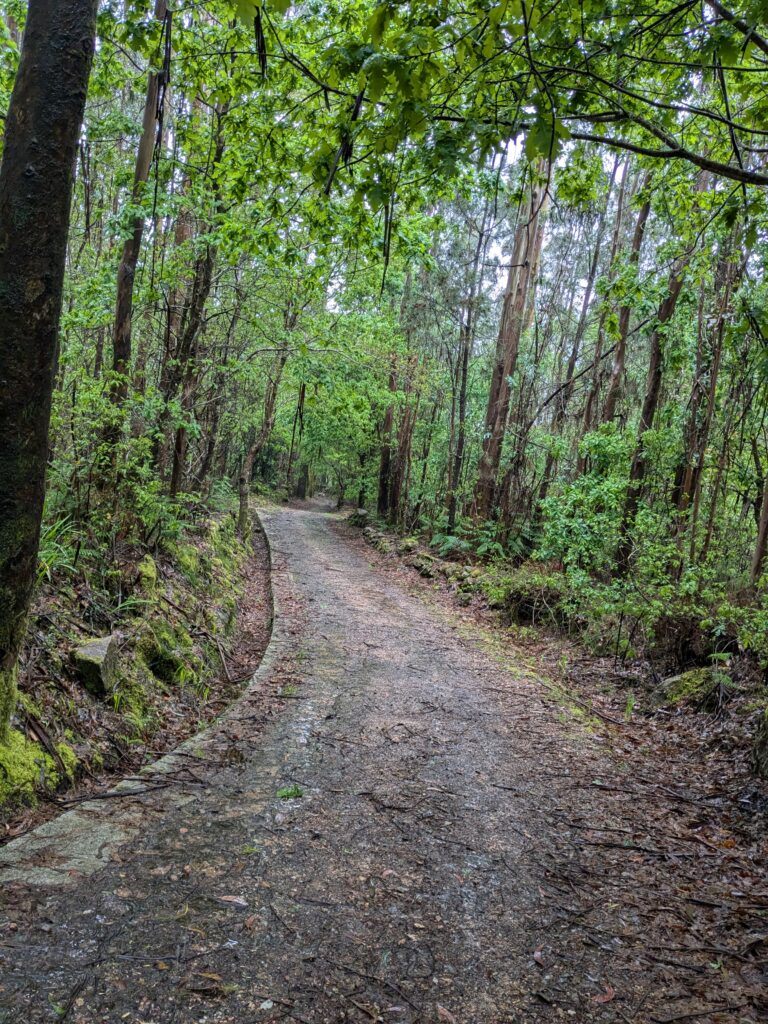

About 10 minutes before arriving in A Grixa, the rain finally stopped. I took off my poncho and looked around: the small village was beautiful, with the sun making a shy return. I needed to wash and dry all my clothes—again.
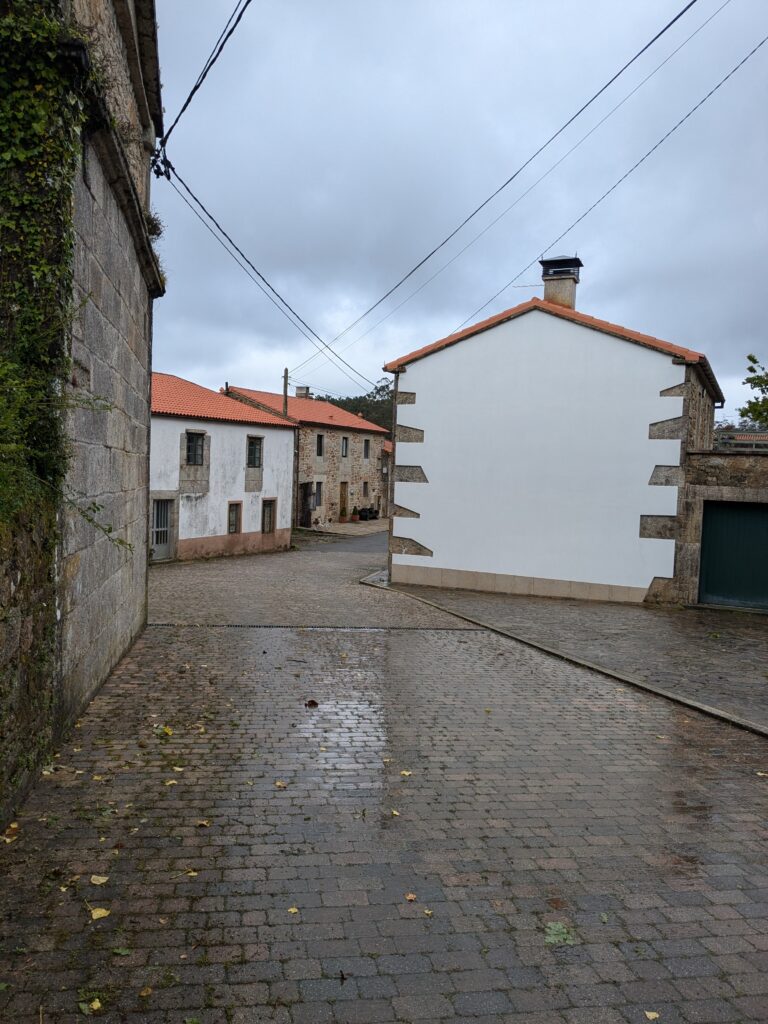
Since the path splits just after Hospital, with most pilgrims heading to Finisterre, I noticed fewer people walking toward Muxía. The albergue in A Grixa was quiet, with just four of us staying there—quite a change from the previous night’s full albergue. The owners were incredibly warm and welcoming. I met a Spanish couple from Burgos, and the man’s name struck a personal chord—it reminded me of people in my life who had represented love, work, and friendship.
We ended up talking for quite a while. I shared my dream of moving to Spain – talking about my job and passion made me feel alive again. They even thought I was Spanish at first, which was the best compliment—they told me my Spanish was excellent.
That night, as I lay in bed and replayed the day in my mind, I couldn’t help but reflect on the emotional and physical storm I had just walked through. It had been one of the toughest days—wind, rain, fatigue, uncertainty—but something within me had shifted. The storm wasn’t just outside. It had mirrored what I had been feeling inside: doubt, restlessness, fear about the future. It was as if the camino, in its mysterious way, had created the perfect conditions for inner cleansing.
Every gust of wind, every slap of rain, had peeled away layers of resistance. As I pushed through, I wasn’t just enduring the elements—I was releasing thoughts that no longer served me. The fear of not knowing what comes next, the frustration of waiting for the “right time” to follow my dreams, the inner critic telling me I should be doing more, or doing things differently—all of it poured down with the rain and got carried away with the wind.

When the sun came out just before arriving in A Grixa, it wasn’t just the weather that changed. I felt it deep inside: a sense of renewal. As if I had survived a test and emerged lighter, more grounded, and even hopeful. The storm had stripped me of my doubts, and in that clarity, I was left with the simple truth that I am worthy—worthy of joy, of love, of following my calling.
The sun after the storm felt like a gentle reminder: even in the hardest moments, beauty can be found. The peace I felt was real. Not the kind that comes from ease or comfort, but the kind that comes from walking straight through difficulty and discovering, on the other side, a stronger, wiser self.
That night, I drifted off to sleep feeling grateful—not just for shelter or dry clothes, but for the storm that had helped me let go.
Day 9 : A Grixa to Muxía – 15km
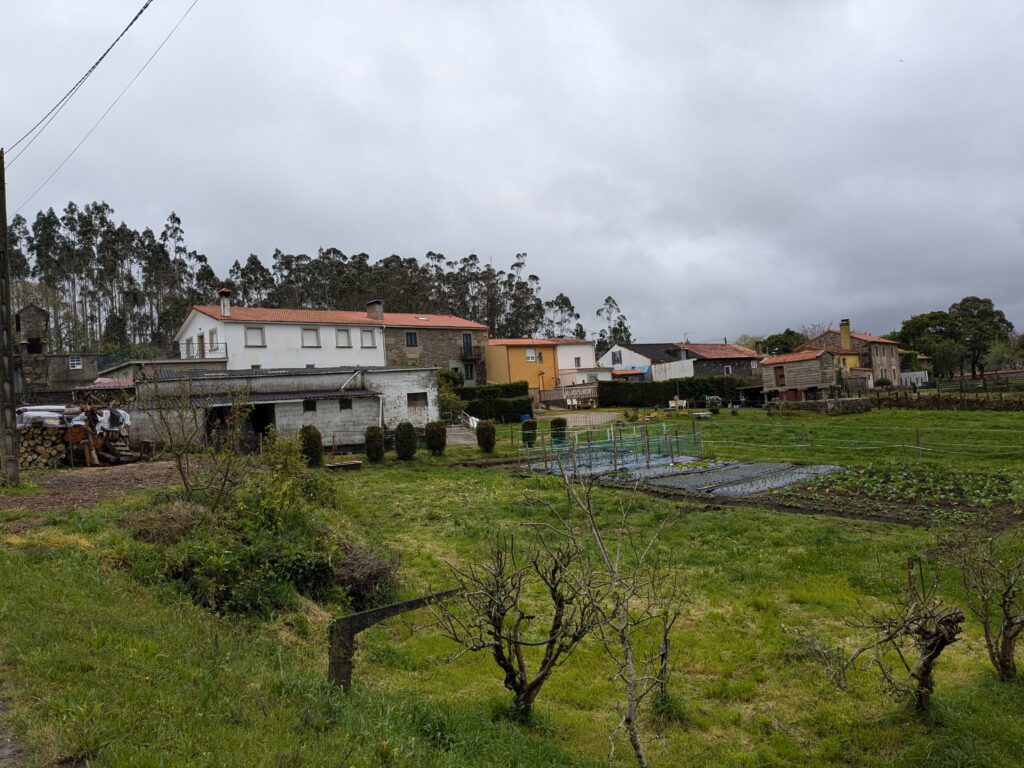
The night before was the first time in days I slept really well. After a short morning meditation, I had breakfast and enjoyed a lovely chat with the Spanish couple I’d met the day before. At 9:30 AM, I set off on the camino again—no storms this time, only a light drizzle that faded after half an hour. The weather was mild and peaceful.
The path led through a beautiful forest, and before long, I came upon the first few villages. I couldn’t help but admire the rustic architecture of the stone houses. Some of them seemed like something straight out of a dream. I caught myself imagining what it would be like to own one and turn it into an albergue.
As I walked, I practised feeling gratitude, worthiness, and love. My body warmed up, especially my upper body and hands, even though the air was chilly.
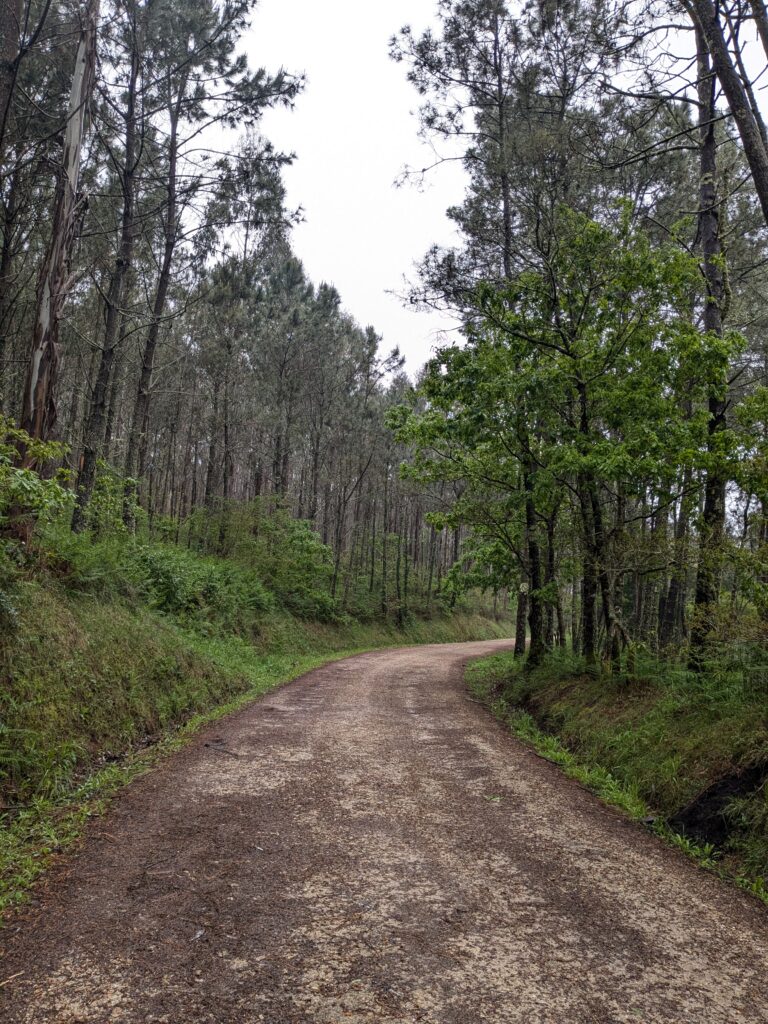



I only made one short stop in Os Muiños, with just 4 km left to Muxía. Soon after leaving the village, I saw the sea for the first time. It took my breath away. I stood still, smiling, in total awe of the moment. I first wondered if the town across the bay was already Muxía, but it turned out to be Camariñas.

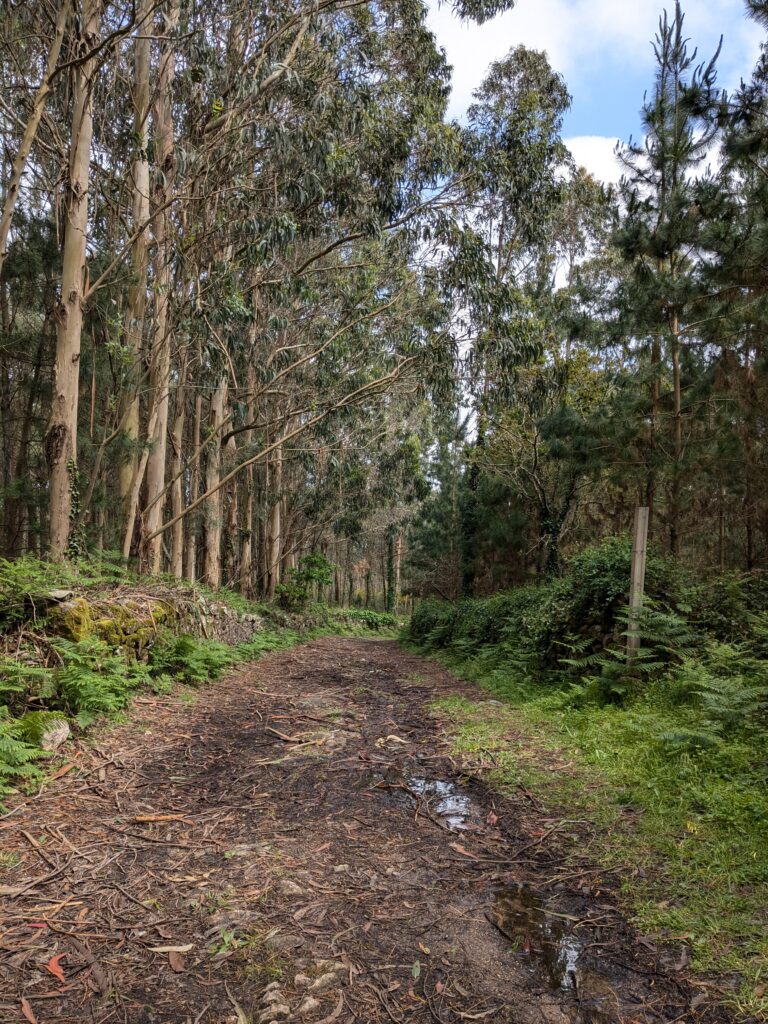
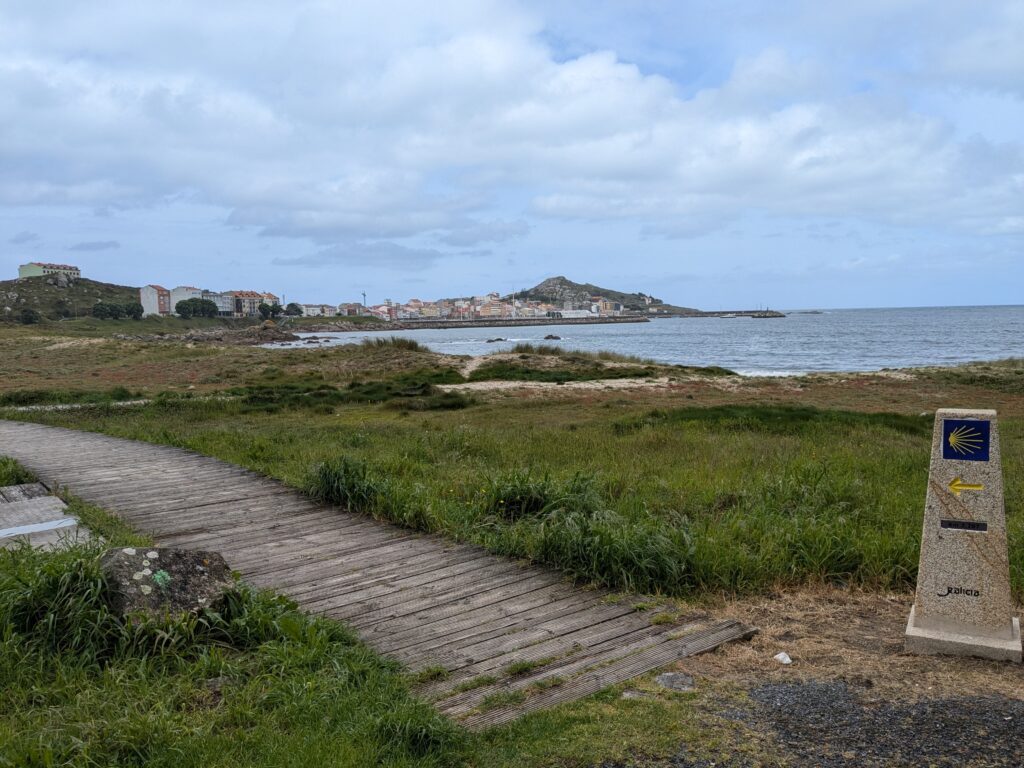

I continued smiling the whole way to Muxía. I arrived around 2:00 PM and went directly to the albergue I had in mind—Muxía Mare. Luckily, they had space and even issued me the Muxiana certificate right there. It felt more special than the Compostela itself.
Backpack dropped off, I headed straight for the Santuario da Virxe da Barca to complete the final kilometres of my camino. Walking along the coastline, hearing the waves crash against the rocks—it was absolutely breathtaking. The wind was strong and wild; my hair was fluttering in all directions. Reaching the Sanctuary was freeing. Holy music played inside, and for a brief moment, time seemed to stand still.
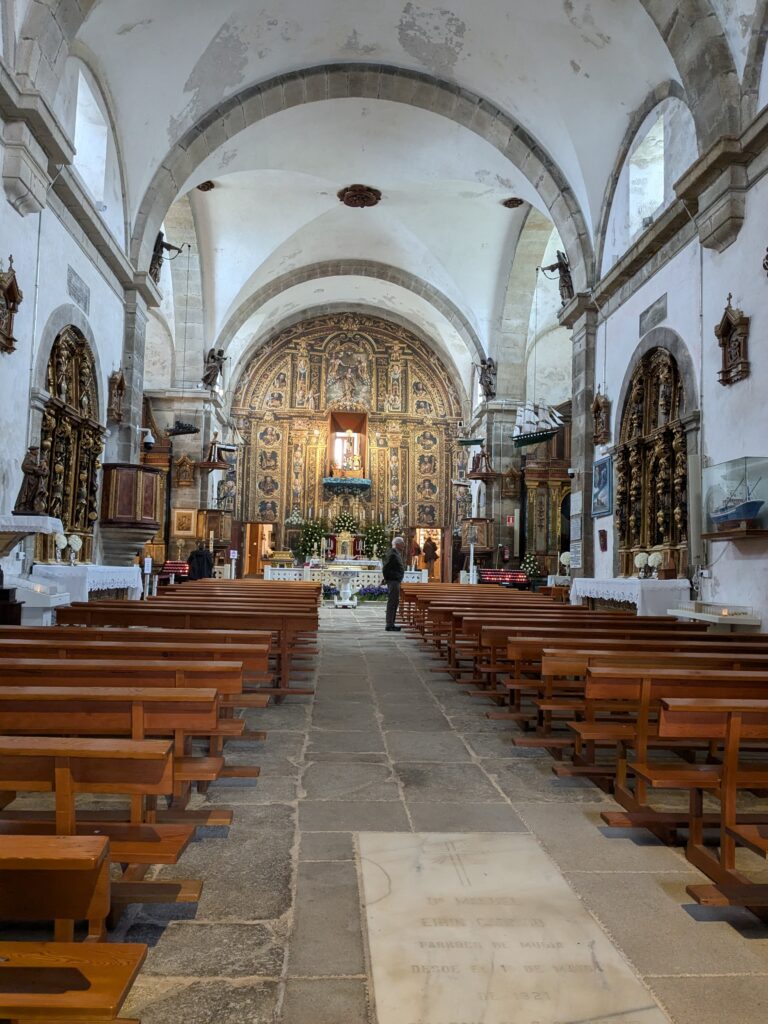
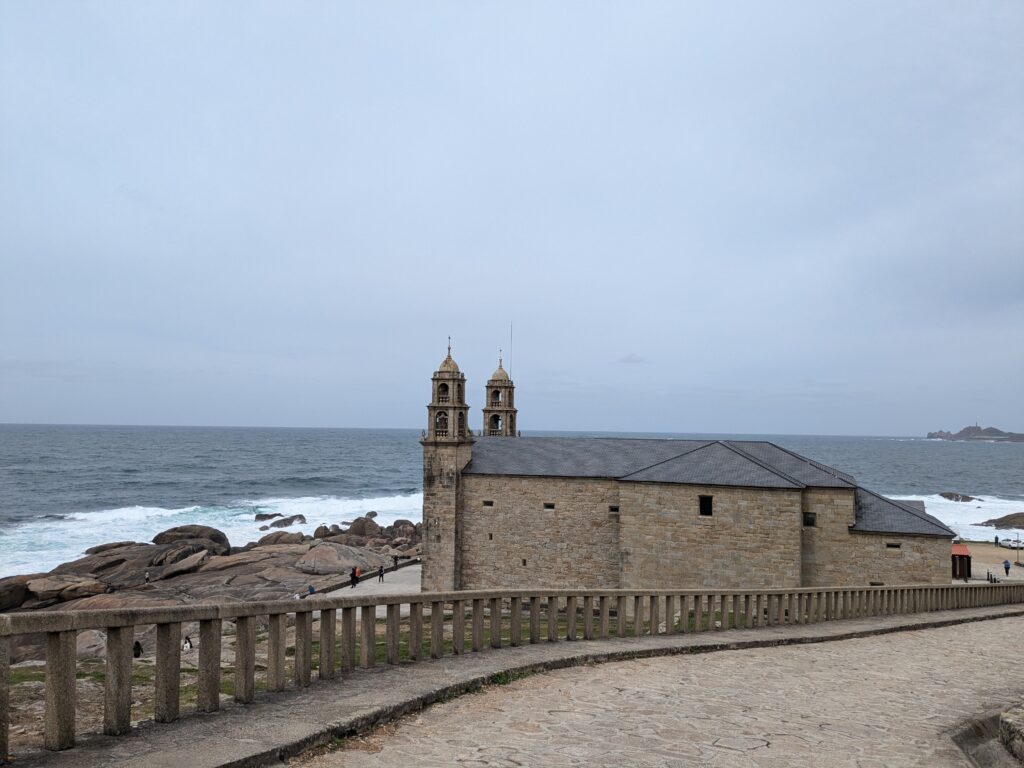
Inside, I was amazed by the symbolism—wooden boats hung from the ceiling as reminders of the sea and the Virgin’s legendary arrival by boat to meet Santiago.
I made my way to the km 0 marker, feeling like I’d reached the end of something big—more so mentally than physically. I had left chapters of my past behind and could sense new doors opening. Some doors were familiar, others completely new, but all suddenly felt closer and more possible.
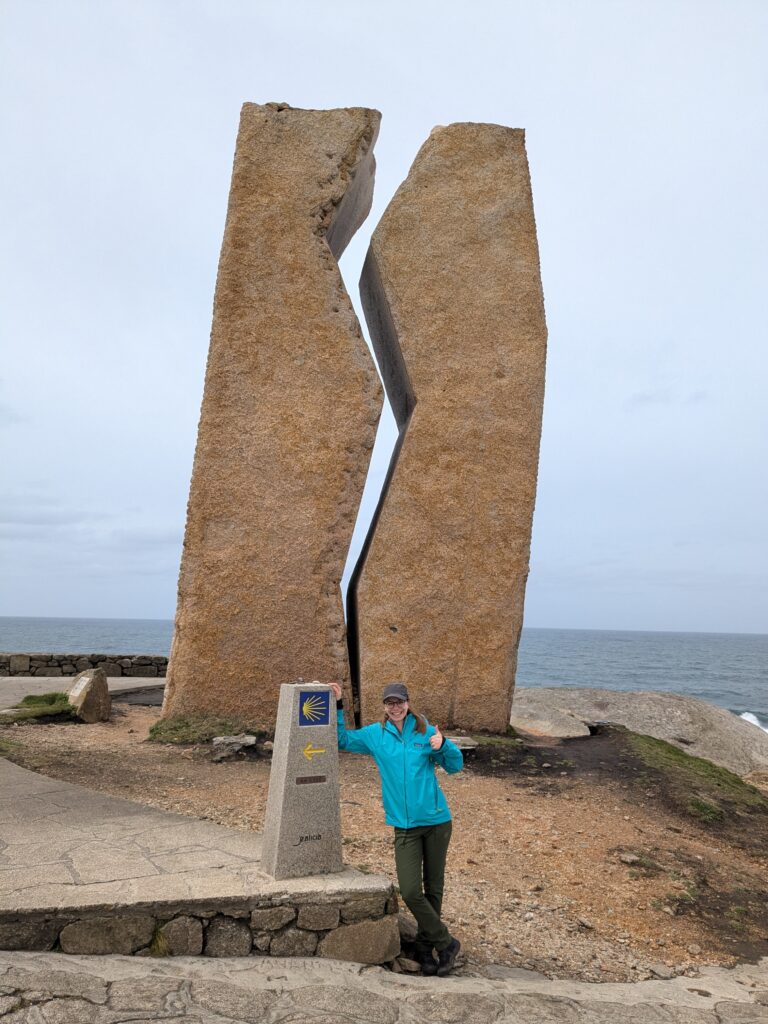
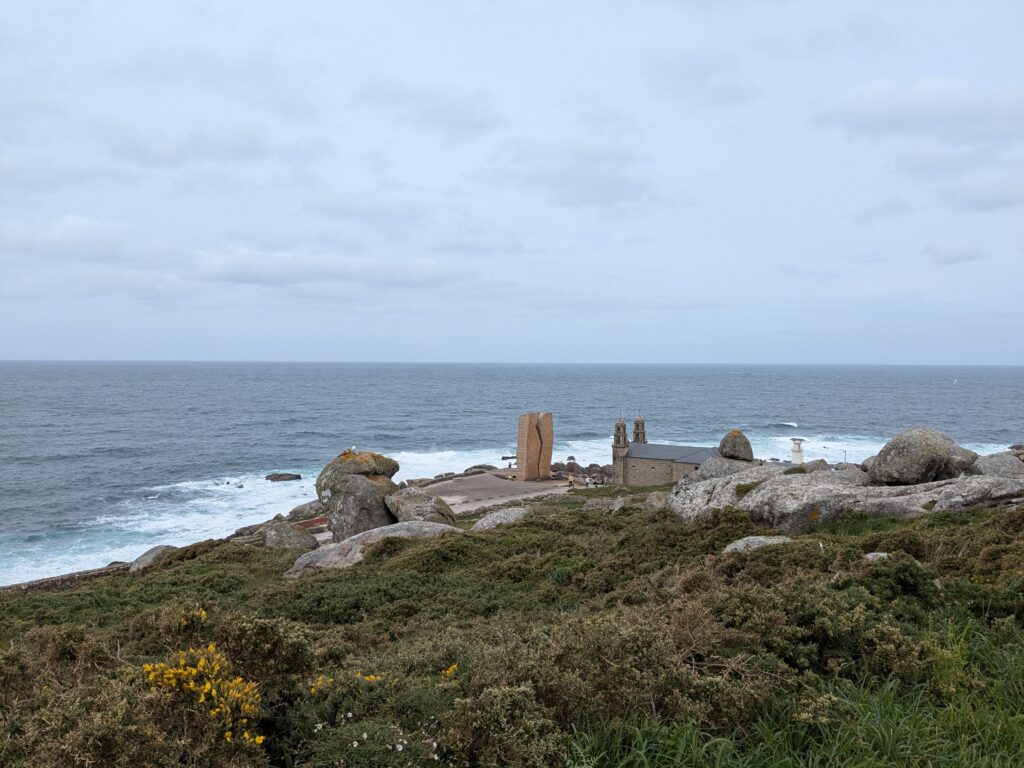

I wandered around the magical stones surrounding the Sanctuary, soaking up the unique energy of the place. It truly offered a different perspective on everything. My gurgling stomach soon reminded me it was time for food, so I walked back into town and found a restaurant.
I was about to eat my tapas seafood rice at a restaurant the waiter had just brought when a huge seagull swooped down and stole it. Everyone laughed. It turned into a fun conversation starter with a woman from Montreal. I had crossed paths with her earlier on the Camino—another not-so-coincidental encounter. I also ended up seeing her again later at the albergue, where she came to get her Muxiana on my recommendation.
I kept bumping into familiar faces, among which an older Dutch couple I kept seeing in Muxía—they were living sailing on a yacht. We shared a few laughs and warm stories.
Before sunset, I went to the Sanctuary again to get a special stamp on my Credencial. I had missed out on the stamp because I didn’t know you had to ask for it in the little shop on the back of the church. I made it just in time, as they were closing at 8pm. But the closing time is not like in Switzerland, they would stay a bit longer. I made it just before closing (thankfully, closing time here is a bit more relaxed than in Switzerland). The stamp even changes depending on whether you finish in Muxía or continue on to Finisterre.
I ended my night with a light dinner, picked up some breakfast supplies from a little shop that was still open, and returned to the albergue—where I met the Spanish couple again. We laughed so hard together. It felt like the perfect closing to an unforgettable day.

That evening, as I was reflecting about my day, I realised that Muxía wasn’t just the physical end of this stage—it marked the end of something within me and the quiet beginning of something new. There was no need to prove anything, to rush, to be more. I had walked through storms, both literal and emotional, and what remained was peace—and a quiet, growing certainty: that I am on the right path, not just on the Camino, but in life. The sea, the Sanctuary, the sacred silence of Muxía… they had whispered back to me the truth I’d been walking toward all along—that I am allowed to dream, to trust, to take my time, and to belong, wherever I choose to be. In my heart, I knew my soul belonged to Galicia, it was calling to me.
Last day, Day 10: From Muxía to Finisterre, 30km

I left Muxía at 7:30 AM under a cool, cloudy sky—perfect walking weather. The route started with some climbs, especially just after Muxía, but I enjoyed every step.
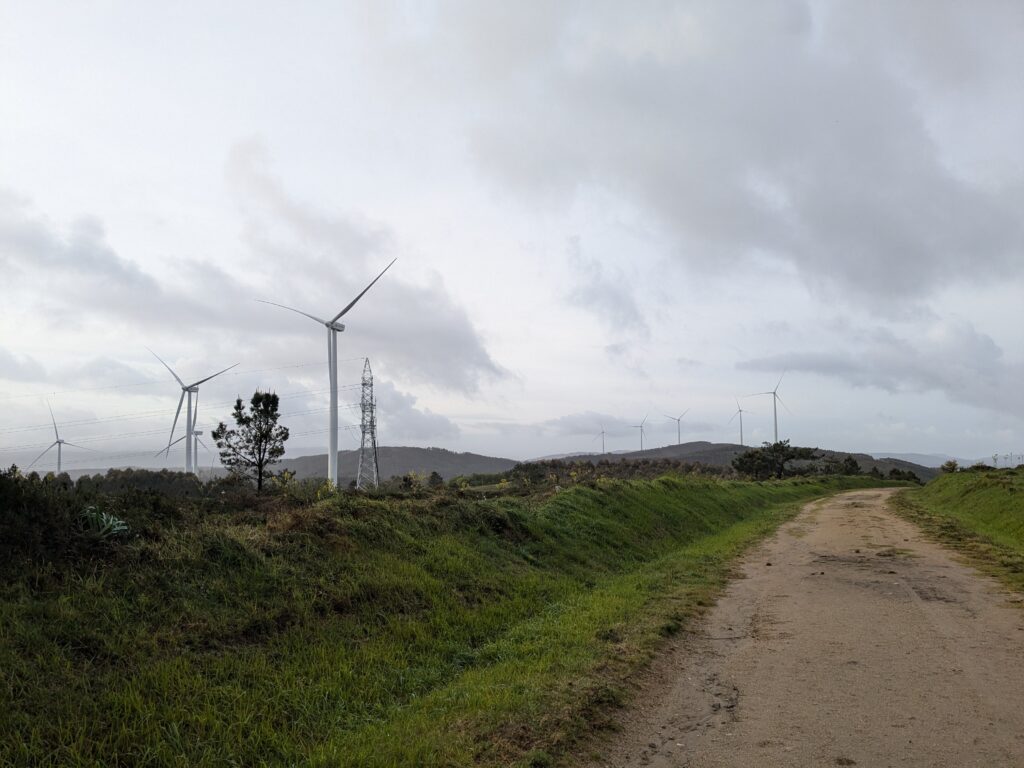
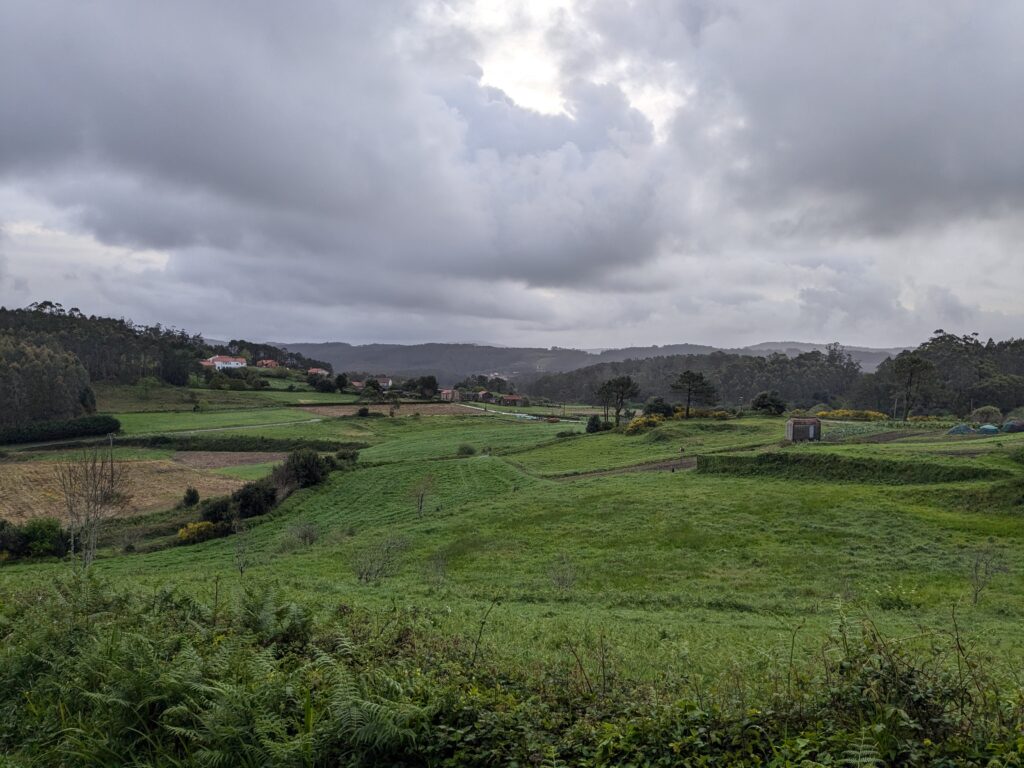
The path took me through quiet forests, up hills on some mountain paths. Around me, windmills turned slowly in the distance—impressive, though they did interrupt the otherwise stunning natural scenery. Not many cafés on this stretch – just one after 1.5 hours, and another hidden one in Morquintián.
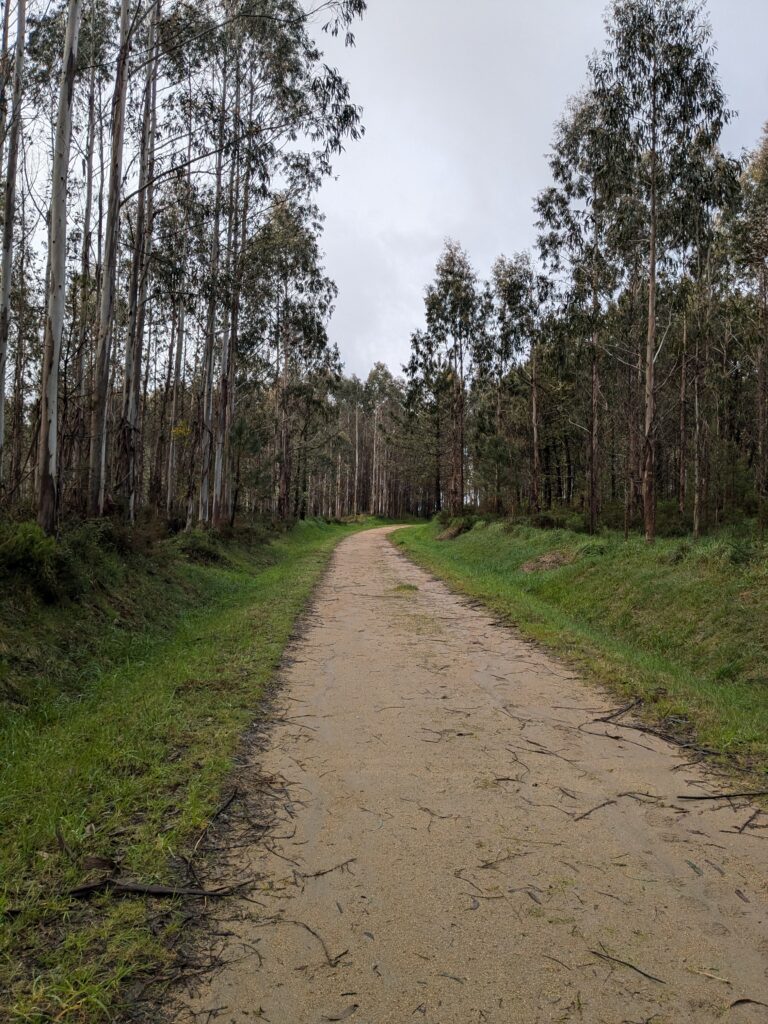

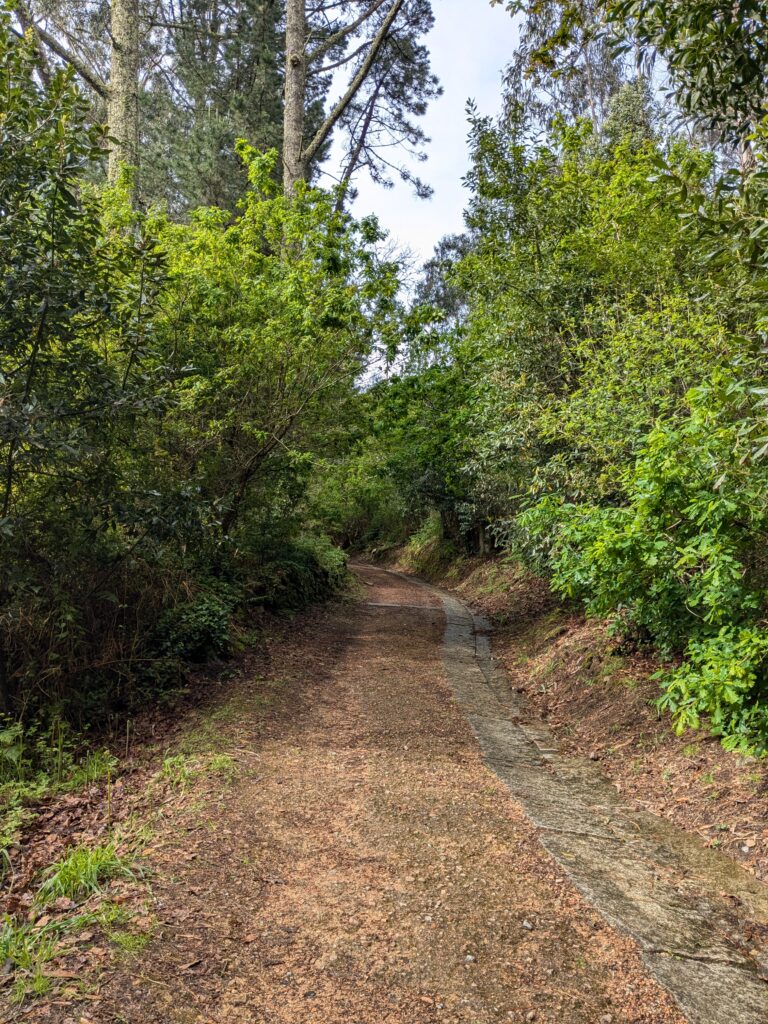
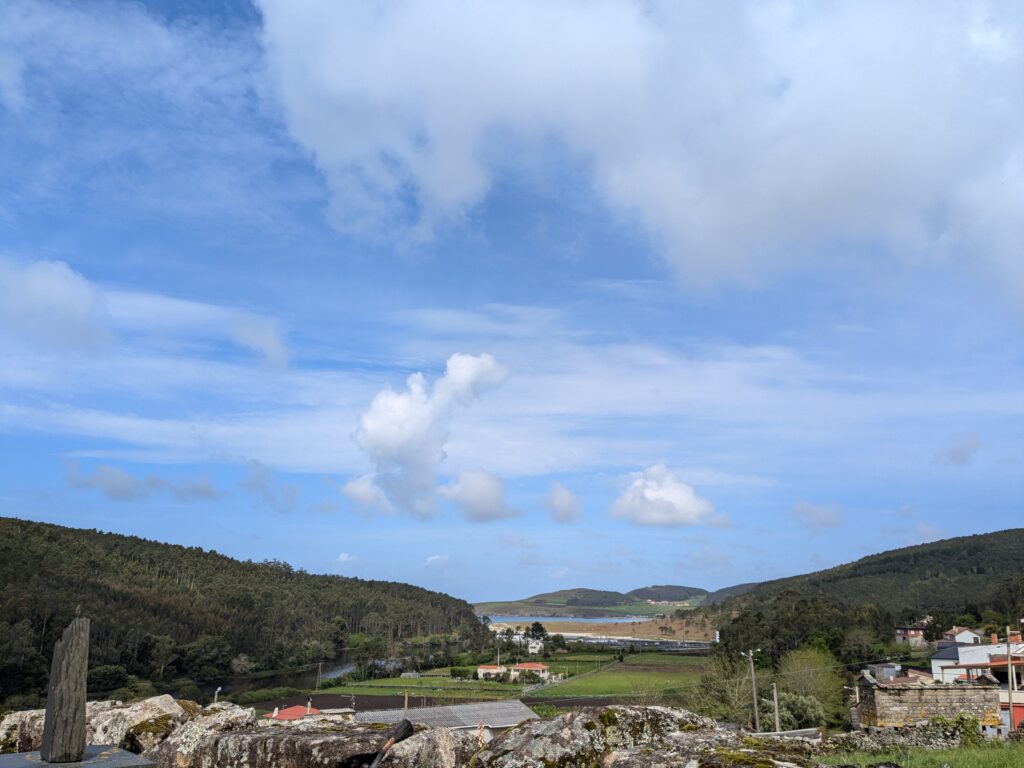
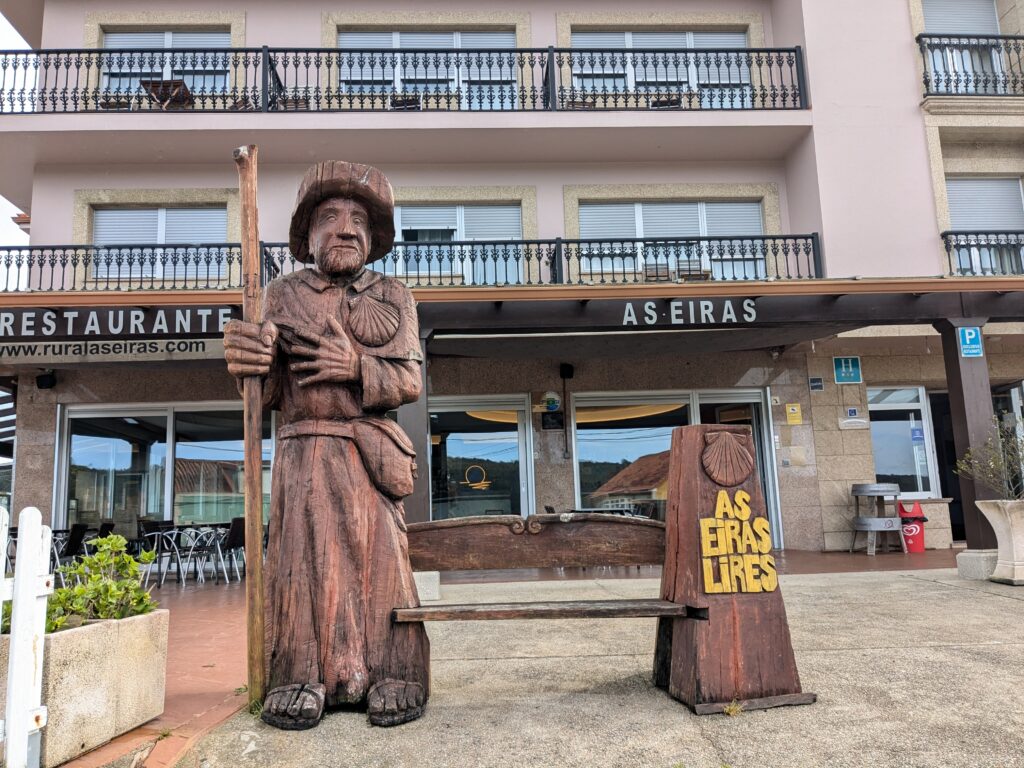
I set foot from Lires at noon, another 15km.
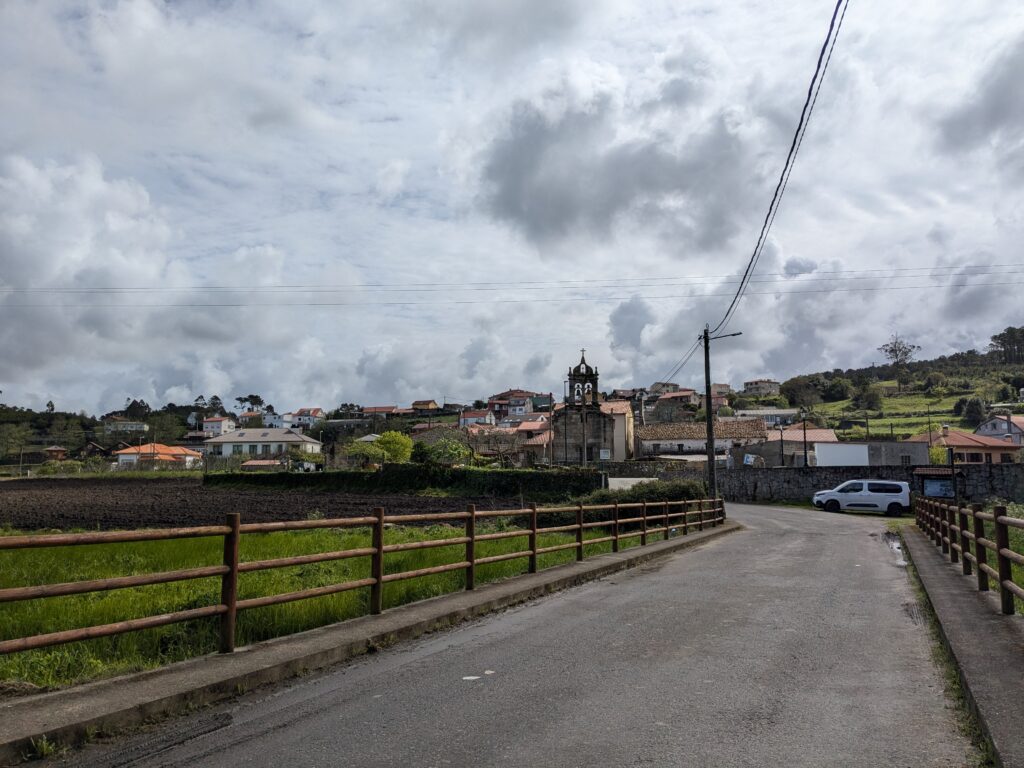




After Lires, I stopped at a donativo café in Buxán run by a lovely guy who’d also done the Camino. We talked for a while – he thought I was local. I told him I wasn’t, but I’m thinking about moving here.
Further along, I reached San Salvador de Duio (just about one hour before Finisterre), but the only café was closed. I met two English women resting at the deserted café. Closer to town, I crossed paths with two exhausted Portuguese pilgrims. We encouraged one another through the final stretch.

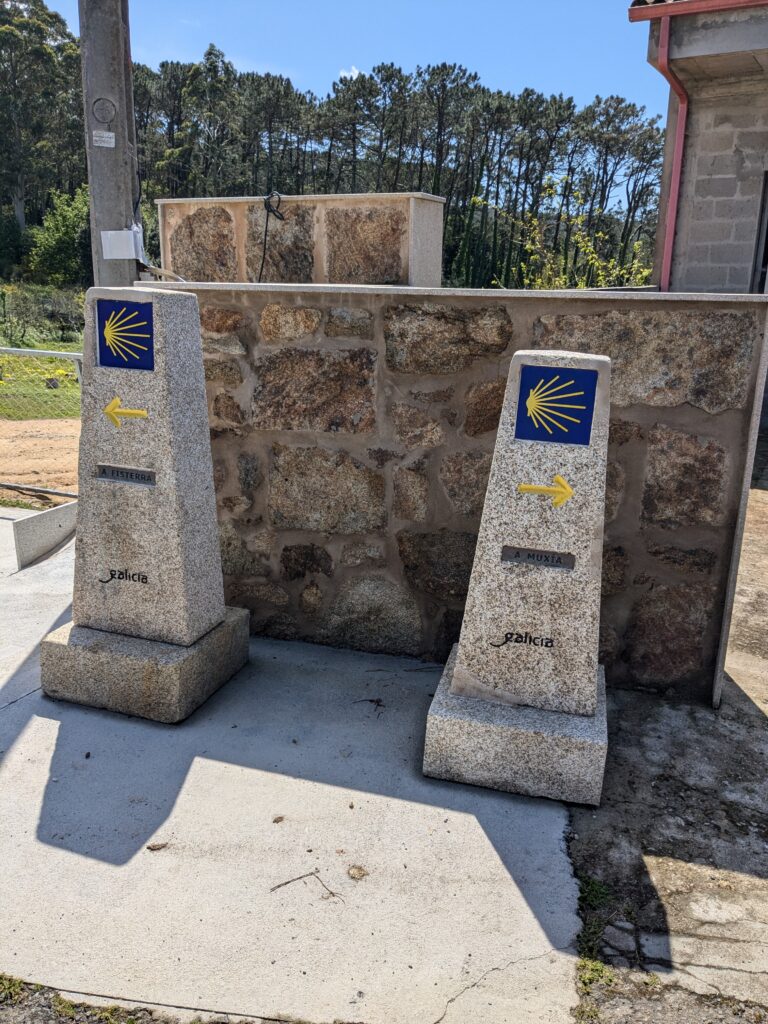
One unique thing about the Muxía–Finisterre route is that pilgrims walk in both directions, and there are no distance markers—just signs saying “A Fisterra” or “A Muxía.” I completely lost track of time.
Despite that, it was a productive walk. My mind was racing with ideas, and I even started recording myself. Creativity was flowing.
I arrived in Finisterre at 4:30 PM. I checked into my pension, had a long, satisfying shower (always a highlight of the Camino!), and changed into my sandals. Before I could rest, there was still one final destination: the Faro at Finisterre, another 3 km walk—6 km round trip. On the way, I stopped by the municipal albergue and received my beautifully illustrated Fisterra certificate.
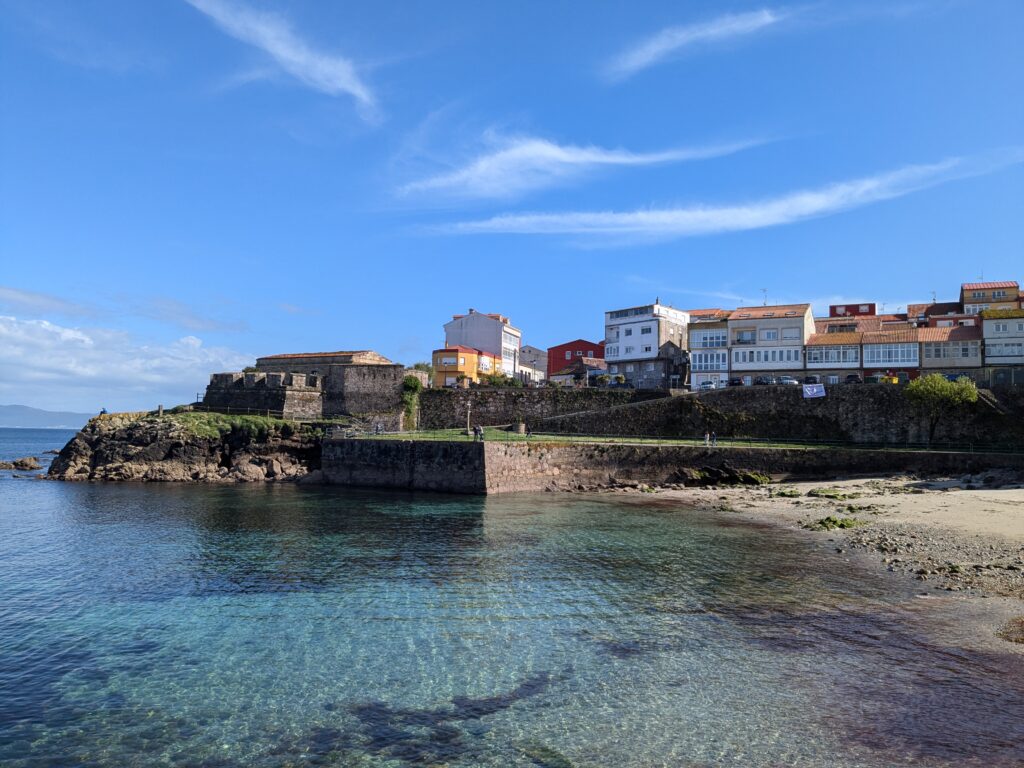
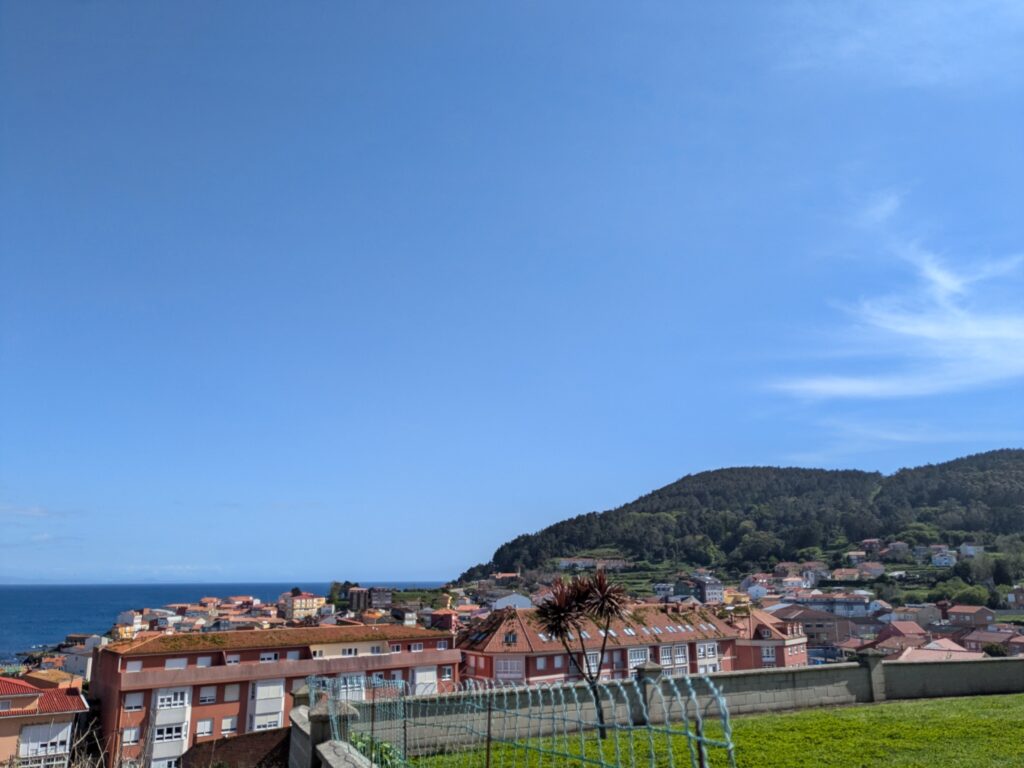

Walking was painful at this point, but the sea views made up for it. When I finally reached the Km 0 marker, it was surreal. I sat in silence near the faro, letting the wind blow through my hair and the sun warm my face. Seagulls called, and waves crashed below. Finisterre—Fisterra, the “end of the world” in the Middle Ages—felt timeless.

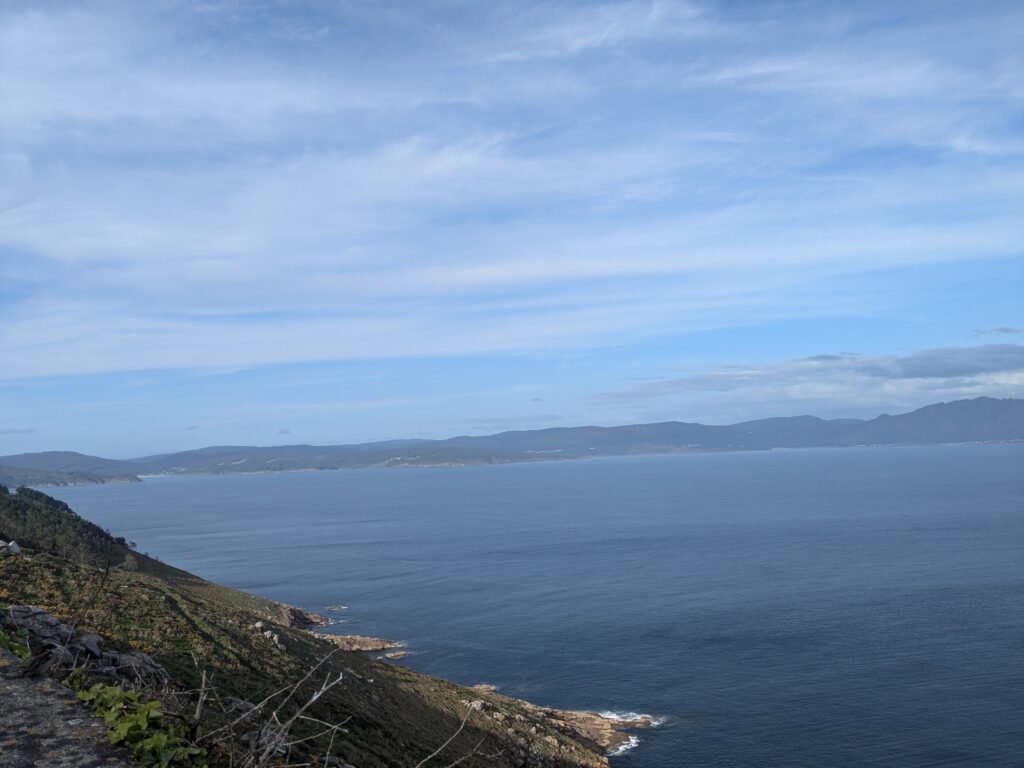
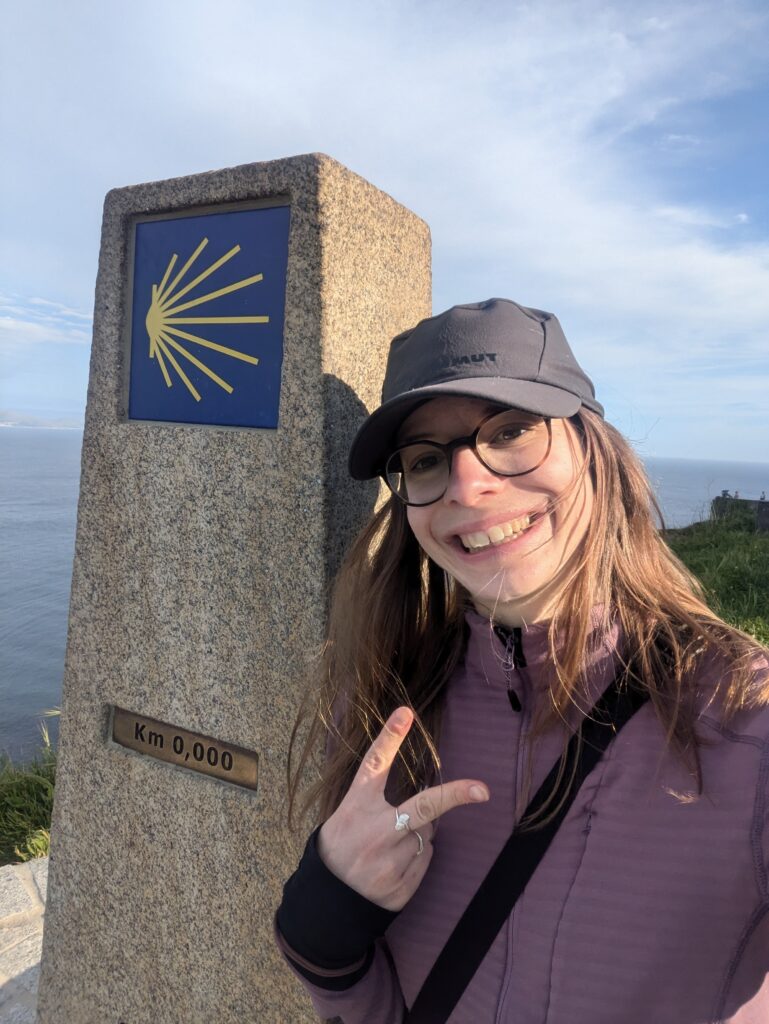
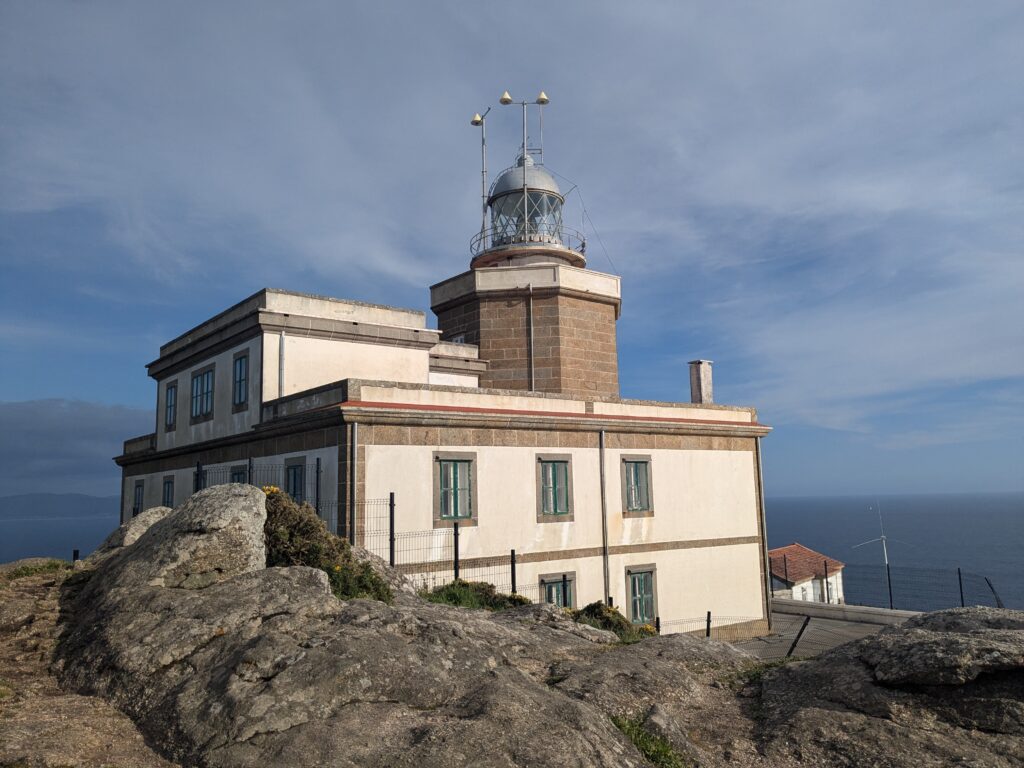
I did a breathing exercise there, marking not only the physical end of my journey but a spiritual pause too. I stayed for a while, absorbing the power of that place. It was a weird feeling having finished the camino.
I didn’t feel like eating seafood despite being on the coast. Instead, I stumbled into a hippie-style restaurant with colourful wall paintings. The waiter was kind and complimented my handwriting as I wrote postcards.
Later, I ran into the Germans I’d seen two days ago—a 72-year-old woman walking with her son all the way from Porto. Camino reunions are always special.
Looking back, I think I preferred Muxía over Finisterre. Muxía is calmer, less touristy, and more picturesque. If I were to do the Camino again, I might stop there instead of continuing to Finisterre. Still, Finisterre carries a powerful symbolism—the edge of the known world, and it also marks the end of the camino.
——————————————————————————————————–
This Camino gave me more than I ever expected. It wasn’t just a walk; it was a shedding of old skin, a clearing of mental space, a reconnection with myself. I faced storms—literal and emotional—but found peace on the other side. I met beautiful souls, reconnected with nature, laughed, and dreamed. I left chapters of my past behind on those paths, and new ideas found their way in.
As I boarded my blabla car to Santiago de Compostela and then the train to A Coruña the next day, I felt ready for what comes next. I spent a few hours exploring the town before my flight, and made a quick visit to the Church of Santiago. There, I picked up a new Credencial.
When asked where I’d start my next Camino, I smiled and said:
“Somewhere on the Camino Primitivo.” I’m already looking forward to the next one and saying “buen camino” to the pilgrims passing by me.

